BEST OF ISTANBUL IN 7 DAYS / 6 NIGHTS BY FLIGHT
THE BEST OF ISTANBUL IN 7 DAYS / 6 NIGHTS - Make your Istanbul adventure totally unique with a private tour. This unique experience to discover Istanbul the city of cities otherwise as Napoleon said if there would be a single capital in the world it would be Istanbul. More information in the description below.
- Category: DAİLY EXCURSİONS & PACKAGES TOUR TURKEY
- Service Length: 45 Minutes
- Price:Free
Description
FROM ANTALYA WITH FLIGHT.
Round trip flight from Antalya + Hotels + Private tour of the monuments on request
THE BEST OF ISTANBUL IN 7 DAYS / 6 NIGHTS
Over several days we establish a package as you wish
All our visits are subject to conditions of possibilities.
Our advice to enjoy your excursion to Istanbul with peace of mind
This excursion is completely flexible according to the possibilities.
Please note that we can completely change the tour itinerary to meet your personal interests. Get the personalized experience of a private tour Customize the itinerary to suit your personal interests Make the most of your limited time in Istanbul
All meals and drinks are not included.Only breakfast at the hotel is included
These proposals are a la carte and flexible according to the possibilities. Prices will be provided on your choice
SUNDAY - DAY 1
Sunday at the end of the day flight to Istanbul, transfer to hotel, installation in the rooms.
FREE TİME + NIGHT AT THE HOTEL
MONDAY - DAY 2
Breakfast at the hotel
Start Private Istanbul Day Tour.
Topkapi Palace with harem, Hagia Irene (If possible due to the works), Hagia Sophia, Blue Mosque, Hippodrome , Egyptian Bazaar and the Galata Bridge
TOPKAPI PALACE (HAREM SECTION INCLUDED )
Topkapi Palace was not only the residence of the Ottoman sultans, but also the administrative and educational center of the state. Originally built between 1460 and 1478 by Sultan Mehmed II, the conqueror of Constantinople, then enlarged and modified several times during its long history, the palace served as the home of the Ottoman sultans and their court until the middle from the 19th century. Duration: around 3 hours
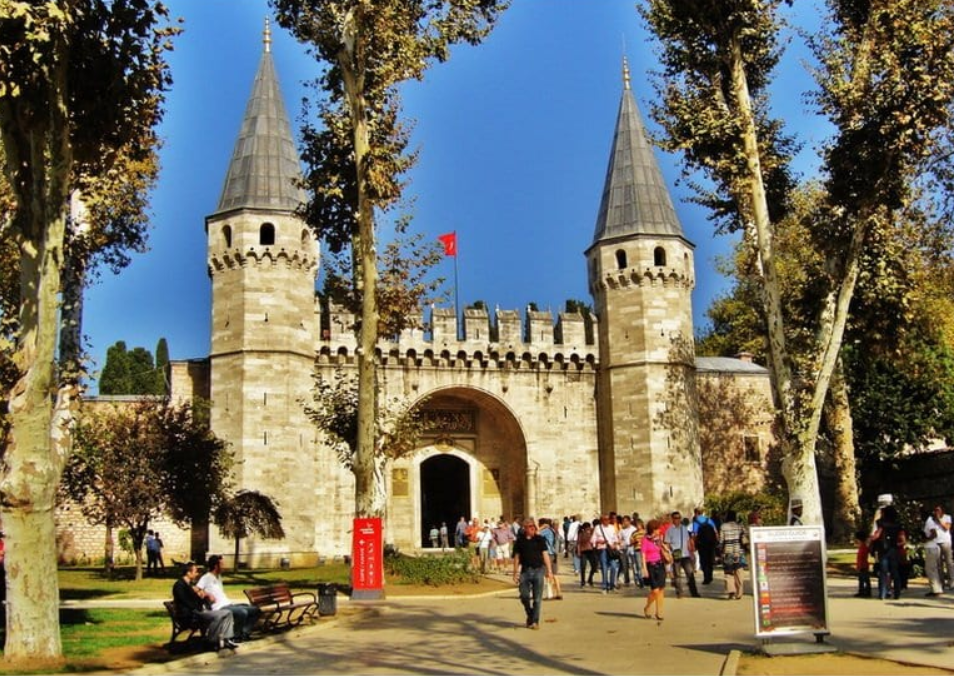
HAREM SECTION
Everything About The Private Life Of The Ottoman:
The Harem apartment, where the Sultans lived with their families in private, was the dwelling of the members of the Ottoman Dynasty and the upper-class women of the Harem for centuries. It also functioned as a school with its own rules and hierarchy. The Imperial Harem of Topkapi Palace is extremely important in terms of architecture and its representation of the styles belonging to the period from the 16th century to 19th century.
It was a forbidden section where no one was allowed to enter except for Sultans, Sultan’s mother, wives and children, the Qadi, the Chief Consort, concubines and the harem guards
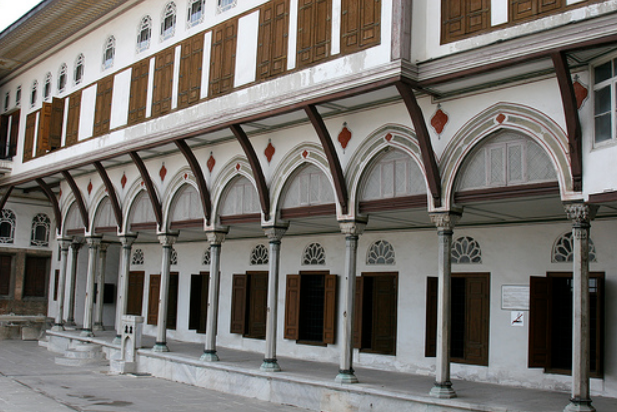
HAGIA IRENE (AYA İRINI) (30 minutes approximately)
If possible due to the works
an ancient Greek Orthodox rite church, located in the outer courtyard of Topkapı Palace in Istanbul.
First built in the 4th century, it was the first cathedral in the city of Constantinople, before Hagia Sophia. It was rebuilt in the sixth century under Justinian, then again, in its current form, in the seventh century. It is one of the few churches in Istanbul that was not converted into a mosque after the fall of Constantinople to the Ottoman Turks, having been used as an arsenal for the warehouse of weapons and ammunition until the 19th century. .
It is now used as a museum and a concert hall. The comparison of the plans and elevations of Hagia Irene and Hagia Sophia, shows that the structure of Hagia Irene prefigures the architecture of Hagia Sophia. Just as the Hagia Sophia Cathedral does not refer to a person who would have been called Sophie, but to the Wisdom of God (sophia in Greek), the Hagia Irene Church does not refer to a saint, but to divine Peace. (irèné in Greek). A more exact translation would therefore be "church of divine peace"
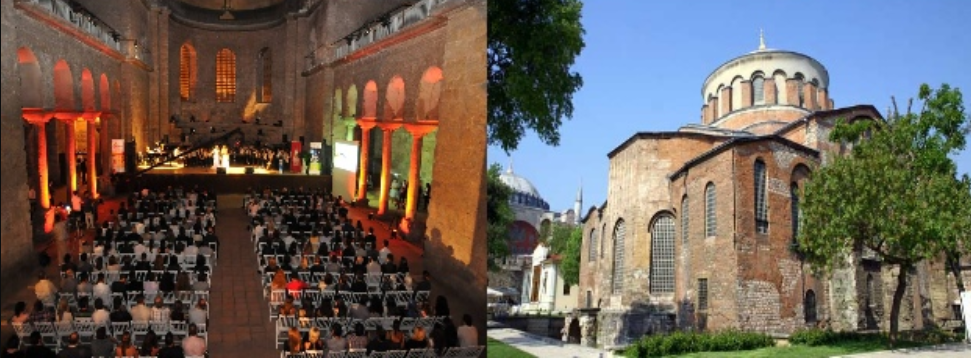
HAGIA SOPHIA MOSQUEE (AYASOFYA CAMII)
The Hagia Sophia, one of the historic architectural wonders that still stands today, occupies an important place in the art world with its architecture, grandeur, size and functionality. The Hagia Sophia, the largest church built by the Eastern Roman Empire in Istanbul, has been built three times in the same location. Duration: around 1 hour
ONCE A CHURCH, LATER A MOSQUE.
Masterpiece Of The History Of Architecture:
The Hagia Sophia Grand Mosque / Ayasofya-i Kebir Cami-i Şerifi, with its innovative architecture, rich history, religious significance and extraordinary characteristics has been fighting against time for centuries, is the largest Eastern Roman Church in Istanbul. Constructed three times in the same location, it is the world’s oldest and fastest-completed cathedral. With its breathtaking domes that look like hanging in the air, monolithic marble columns and unparalleled mosaics, is one of the wonders of world’s architecture history.
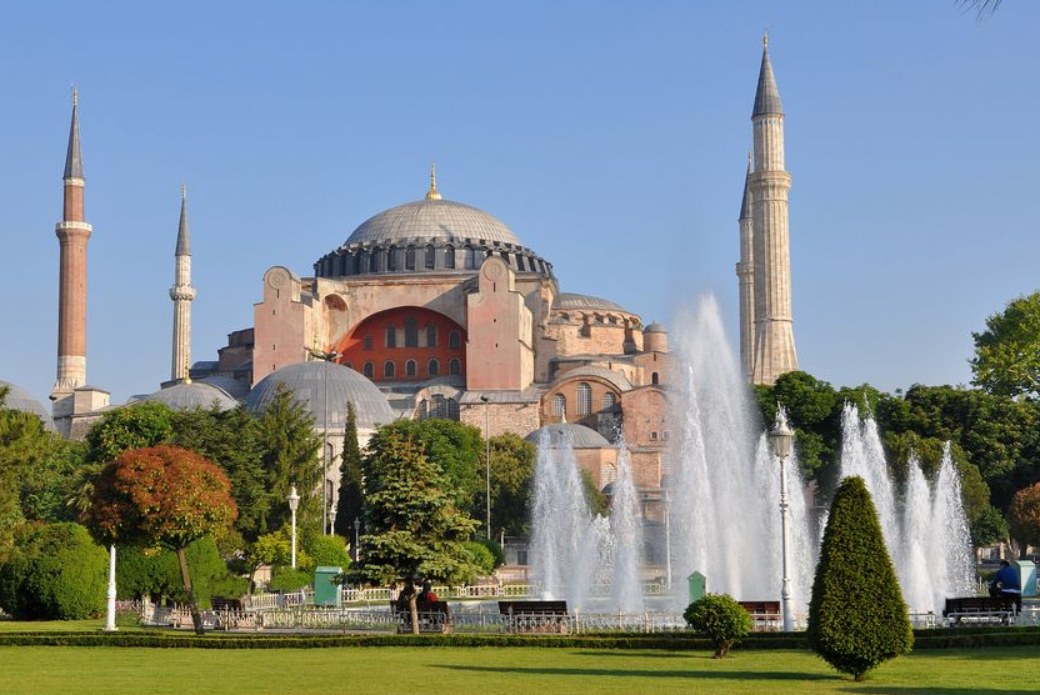
BLUE MOSQUE
The Blue Mosque (called Sultan Ahmet Camii in Turkish) is a historic mosque located in Istanbul. The mosque is known as the Blue Mosque because of the blue tiles surrounding the walls of the interior design. Duration: around 1 hour
The Blue Mosque (Called Sultanahmet Camii in Turkish) is an historical mosque in Istanbul. The mosque is known as the Blue Mosque because of blue tiles surrounding the walls of interior design.Mosque was built between 1609 and 1616 years, during the rule of Ahmed I. just like many other mosques, it also comprises a tomb of the founder, a madrasa and a hospice.Besides still used as a mosque, the Sultan Ahmed Mosque has also become a popular tourist attraction in Istanbul.
Besides being tourist attraction, it's also a active mosque, so it's closed to non worshippers for a half hour or so during the five daily prayers.
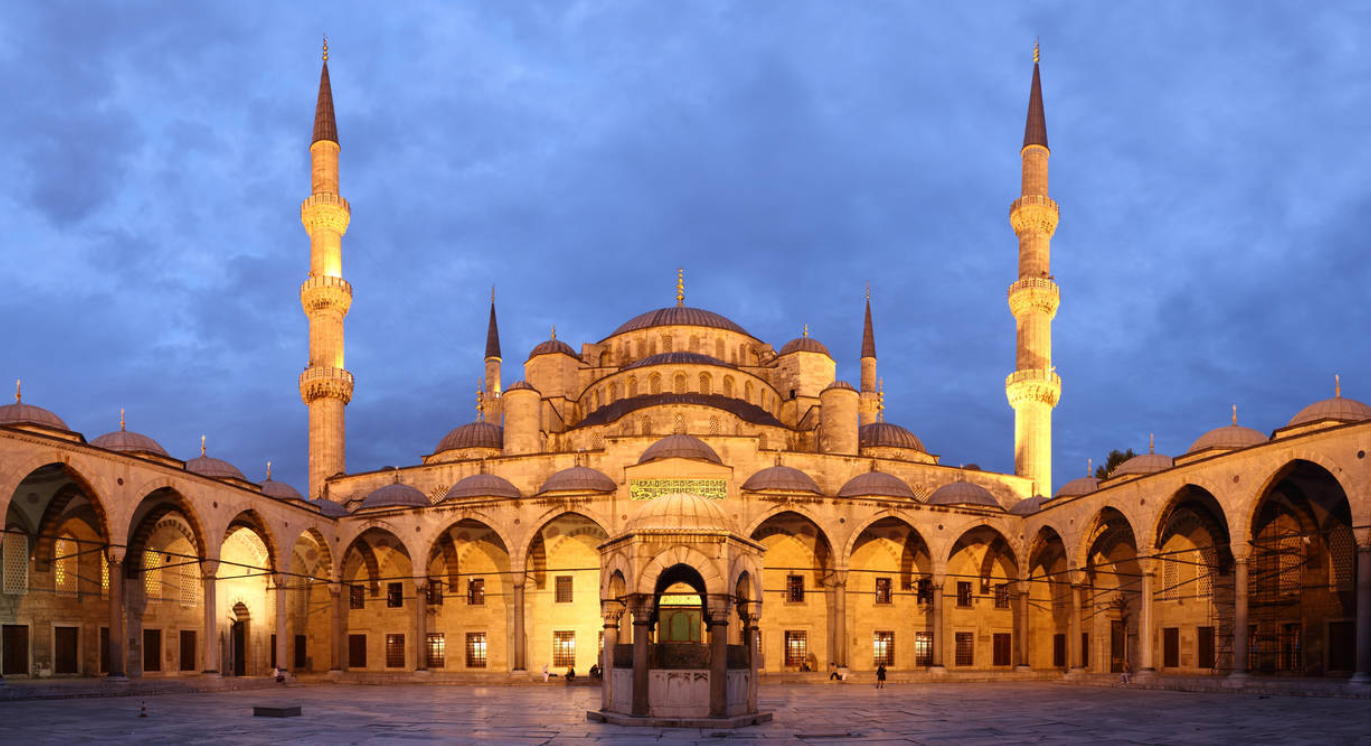
HIPPODROME OR AT MEYDANI
The Hippodrome of Constantinople, located in Sultanahmet / Istanbul, was a public arena mainly devoted to chariot races. The word hippodrome comes from the Greek hippopotamus (horse) and dromos (path). The Hippodrome of Constantinople was also the scene of gladiatorial games, official ceremonies, celebrations, demonstrations, tortures inflicted on the condemned, etc. Duration: around 1 hour
The hippodrome could accommodate about 40,000-50,000 people. The place, which is more or less northeast-southwest in orientation, is in Turkish called Sultanahmet Meydanı or At Meydanı ("Horse Square").
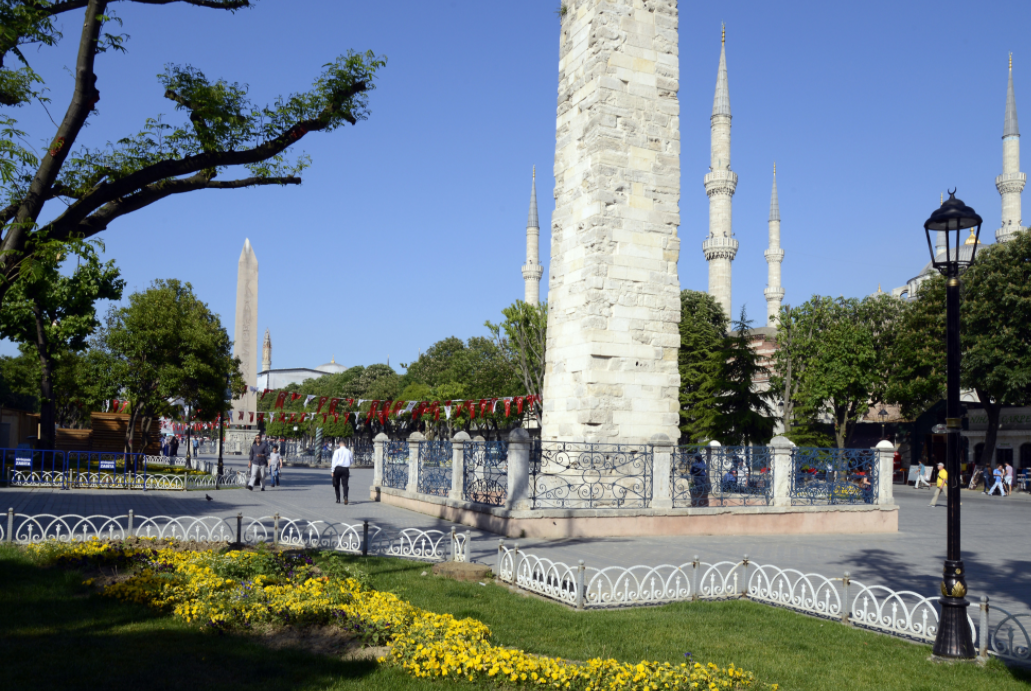
Hippodrome during the Ottoman era
Hippodrome was also used by the Ottomans as well and they named it At Meydanı (Horse Square), yet they simply used it as a square. Constructions of İbrahim Paşa Palace (now housing Turkish and Islamic Art Museum) in 16th century and Blue Mosque in 17th century damaged the hippodrome. Subsequently, mid-eighteenth century onwards it was abandoned and destroyed. Today, the area is known as Sultanahmet Square and it follows the ground plan and dimensions of the hippodrome.
Amazing facts about the Hippodrome of Constantinople
In 390 CE, Byzantine emperor Theodosius I brought the Obelisk of Thutmosis III from Karnak (Southern Egypt) to Constantinople, erected it inside the hippodrome and named it “Obelisk of Theodosius” (Dikilitaş in Turkish). It is one of the twenty-nine Egyptian obelisks in the world. Despite its approx. 3500 years old age, the obelisk is in very good condition.
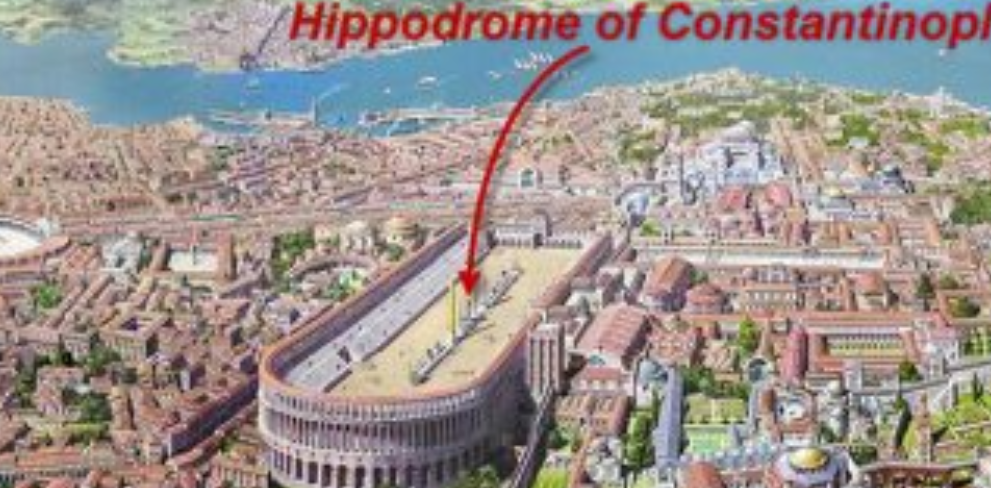
EGYPTIAN BAZAAR AND THE GALATA BRIDGE (MISIR ÇARŞI & GALATA KÖPRÜ)
To end, visit the Egyptian Bazaar. The Spice Bazaar was established in 1663. The Bazaar was originally intended for trade in goods from Egypt. It is, along with the Grand Bazaar, Istanbul's largest market. Scents interspersed with mint, thyme, vanilla, curry, cinnamon and the best place to buy Turkish delight. Duration: around 1 hour
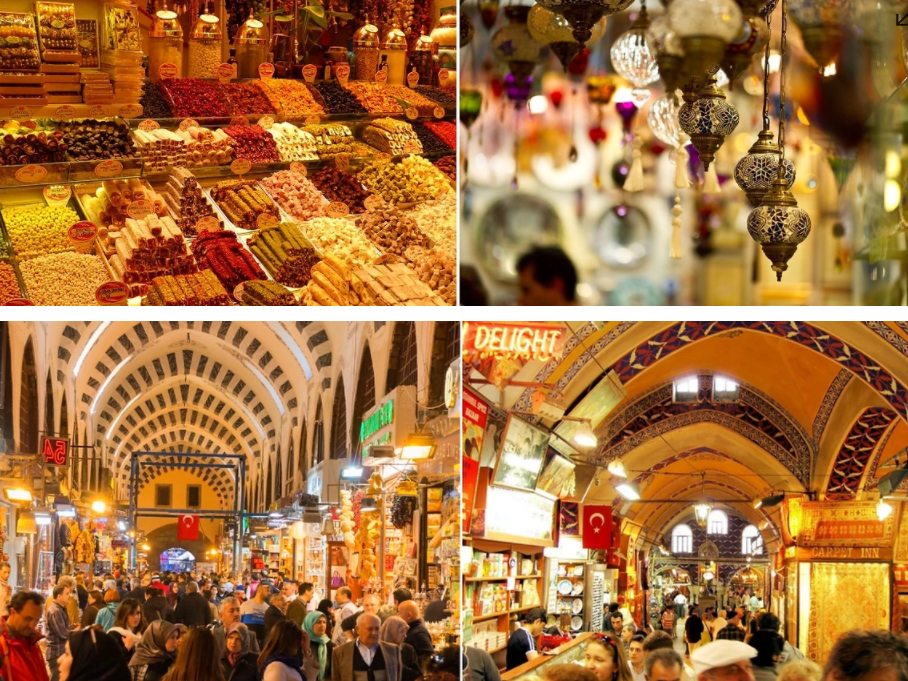
The historical Egyptian Spice Bazaar (Misir Carsisi) or so-called Spice Market, is a colorful and mystical covered spice market lined with spice stalls in Eminonu coast, near the Yeni Mosque, in the Historical Peninsula of Istanbul. It is also one of the most popular covered markets in the world, together with famous Grand Bazaar.
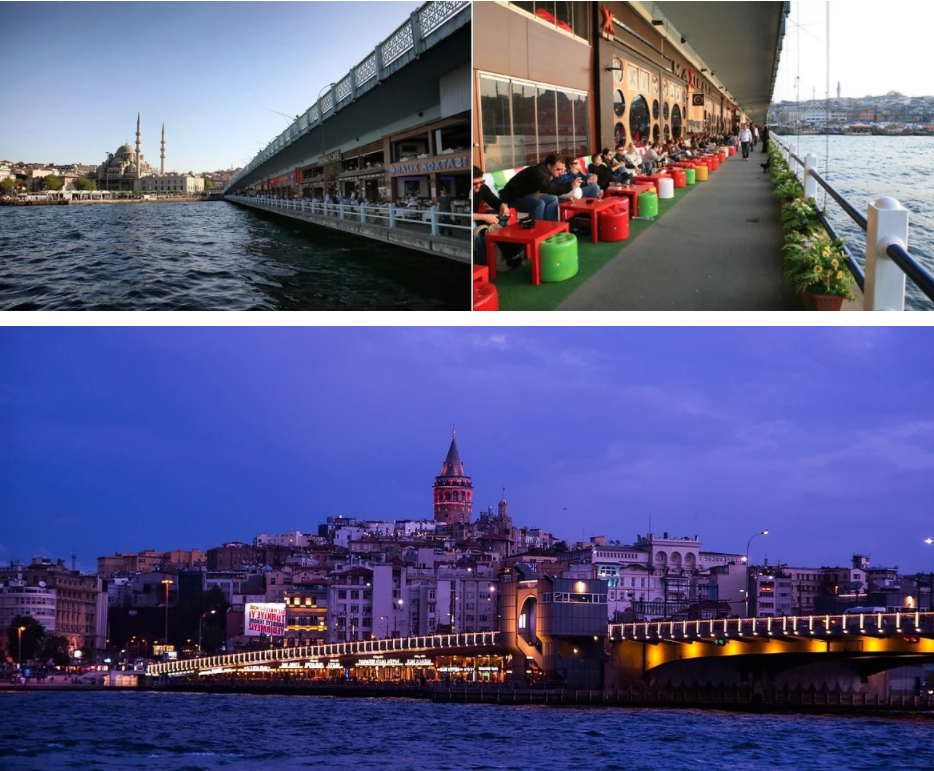
Galata Bridge is the heart of Istanbul, spanning the Golden Horn from Karaköy on the north to Old Istanbul, centered on Sultanahmet, on the south.
Crossing the bridge you look west toward Europe and east across the Bosphorus to Üsküdar and Asia.
Right at the northern end is Karaköy (Galata), a Genoese colony during Byzantine times.
END OF THE DAY ON THE GALATA BRIDGE - FREE TİME + NIGHT AT THE HOTEL
TUESDAY - DAY 3
Breakfast at the hotel
The Basilica Cistern, Istanbul Archaeological Museums, Oriental art collection Museum, Collection of ceramics and jewelry Museum, Grand Palais Mosaic Museum and Museum of Turkish and Islamic Arts
THE BASILICA CISTERN: (1 hour approximately)
Also known by the Turkish name Yerebatan Sarnıcı ("the cistern buried underground"), is a gigantic underground cistern in Constantinople, the capital of the Byzantine Empire, of which it is one of the most spectacular monuments still visible today in Istanbul. The Basilica Cistern is a haven of peace in the heart of the bustling city of Istanbul: its subdued light, little background music and the freshness that emanates from it make it a most enjoyable visit.
Legend of the Underground: Medusa
According to one legend, Medusa is one of the three Gorgonas, the female monster of the underworld in Greek mythology. Medusa, the snake-headed of these three sisters, has the power to turn his ministers to stone. According to one view, Gorgona paintings and sculptures were used to preserve large structures and special places at that time, and this is why the head of the Carnica Medusa was placed.
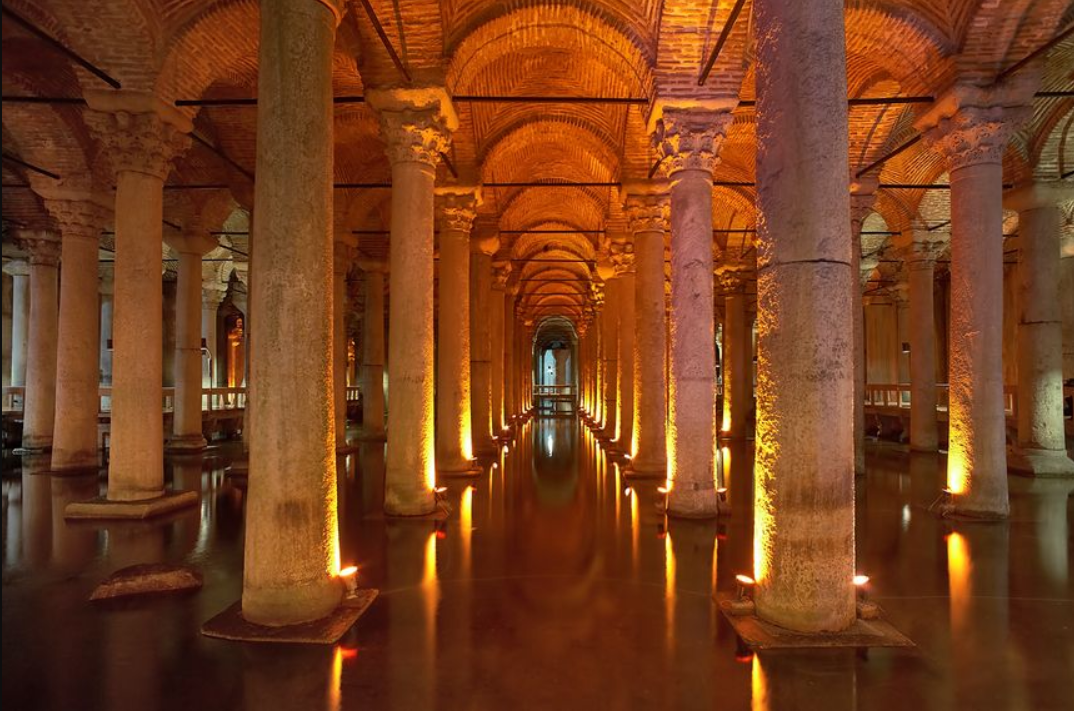
ISTANBUL ARCHAEOLOGICAL MUSEUMS
The Istanbul Archaeological Museum is one of the most important in the world. It was founded by the Turkish painter and archaeologist Osman Hamdi in 1891.
The museum collection is divided into three parts:
Archaeological Museums: (1 hour approximately)
This part houses objects known throughout the world, including a large collection of sarcophagi, including that of Alexander (S. IV). With its large collection of sarcophagi and its many antique objects, the archaeological museum will delight lovers of antiques. The sarcophagus of Alexander and the sarcophagus of Meleager are truly impressive.
There is a wealth of treasures on show from the Assyrian, Hittite, Egyptian, Greek, Roman, Byzantine and Ottoman civilizations. The below are a few of the collections and items not to miss.
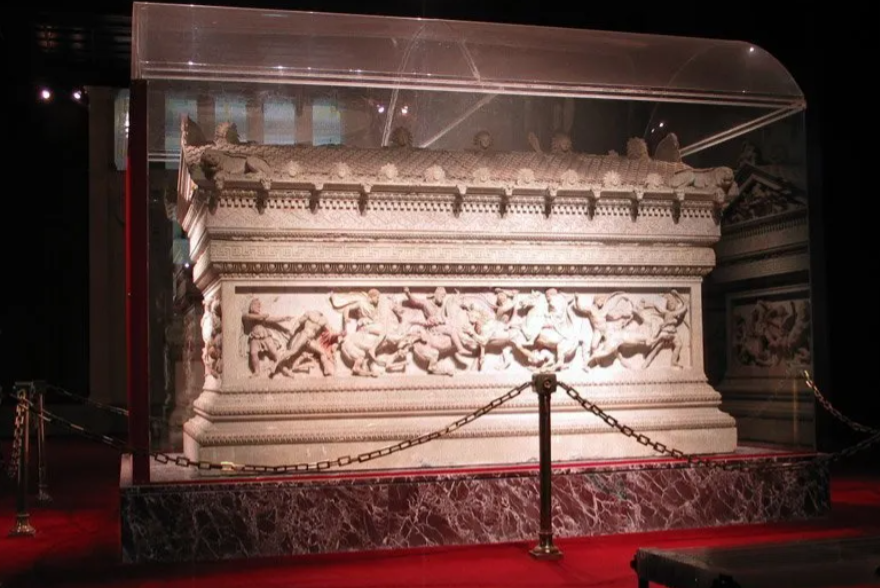
Oriental art collection: (1 hour approximately)
In this part you will find Ottoman burials and artefacts from Egyptian, Sumerian and Akkadian cultures. The most valuable items in this collection are the pieces of the Babylonian Istar Gate.
What not to miss at the Ancient Orient Museum
The Treaty of Kadesh – the oldest peace treaty in the world, written in cuneiform script, signed in 1274 and discovered in the Hittite capital of Hattusa.
The oldest Love Poem from the Ancient Babylonian Era of the 8th century BCE, which begins:
“Bridegroom, dear to my heart,
Goodly is your beauty, honeysweet,
Lion, dear to my heart,
Goodly is your beauty, honeysweet.”
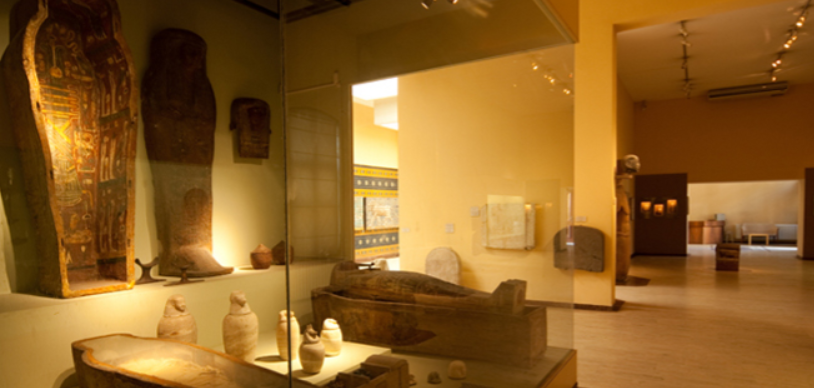
Collection of ceramics and jewelry: (30 minute s approximately)
Earthenware Kiosk (Çinili Köşk). Built in 1472 under Mehmed II the Conqueror, it was originally designed as a pavilion for the relaxation of the Sultan within the grounds of Topkapı Palace. It is one of the earliest examples of Ottoman civil architecture in Istanbul. Mehmed II had three kiosks built in the palace gardens in three different styles - Persian, Greek and Turkish - symbolizing the three universes of which he was now the master. The faience kiosk, built in Persian style, is the only one that remains today. Its decoration was entrusted to master ceramists from Khorasan, who used monochrome techniques in the Timurid tradition.
It was from this pavilion that the Sultan watched his pages play djirit, the ancestor of polo. The Earthenware Kiosk was remodeled and attached in 1981 to the Istanbul Archaeological Museum, and today displays an exceptional collection of Iznik and Çanakkale ceramics, as well as Seljuk works. The museum has more than 2000 pieces. The facade of the pavilion, with its marble portico supported by 14 columns and its gallery covered with ceramic tiles, is in itself worth a detour. But the building itself is interesting.
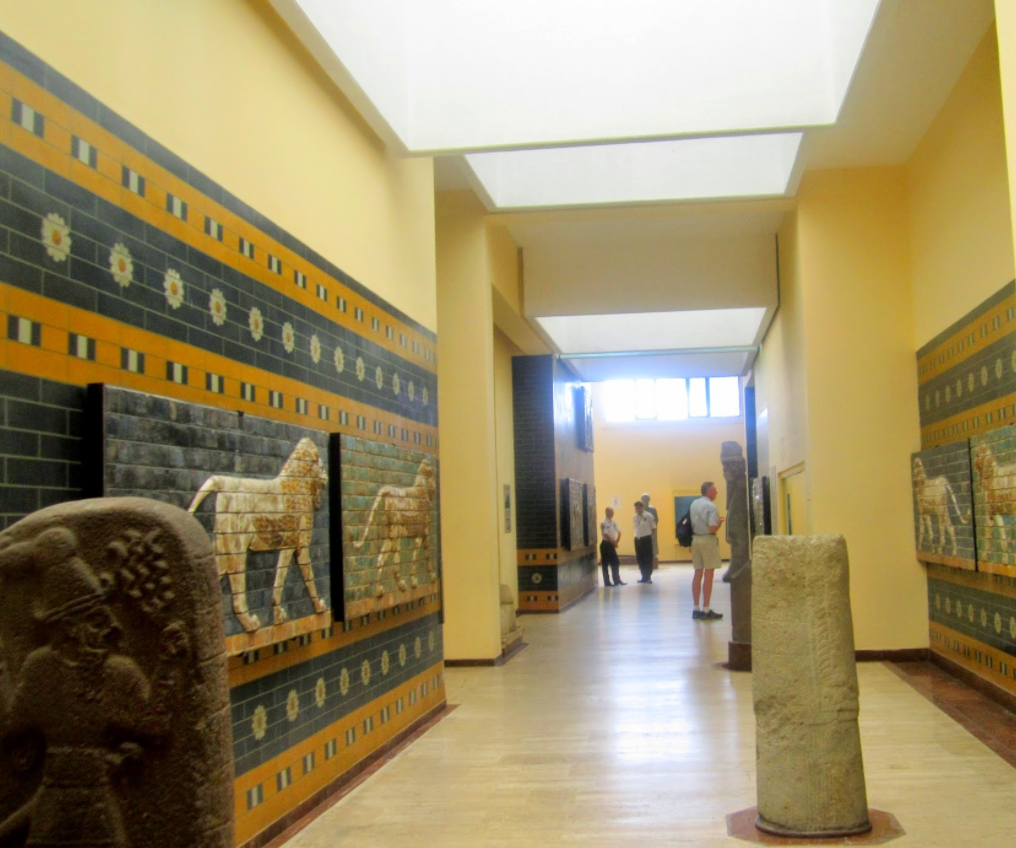
GREAT PALACE MOSAICS MUSEUM (30 minutes approximately)
The Grand Palace Mosaic Museum (Turkish: Büyük Saray Mozaikleri Müzesi) in Istanbul houses mosaics from the Byzantine period unearthed during excavations of the Grand Palace in Constantinople. It is located near the Hippodrome of Constantinople (Istanbul, Turkey) .The museum collects the mosaics used to decorate the floor of a peristyle possibly dating from the reign of the Byzantine emperor Justinian I (r. 527 - 565), although the most recent analyzes allow us to put forward a later date even dating back to the reign of Heraclius.
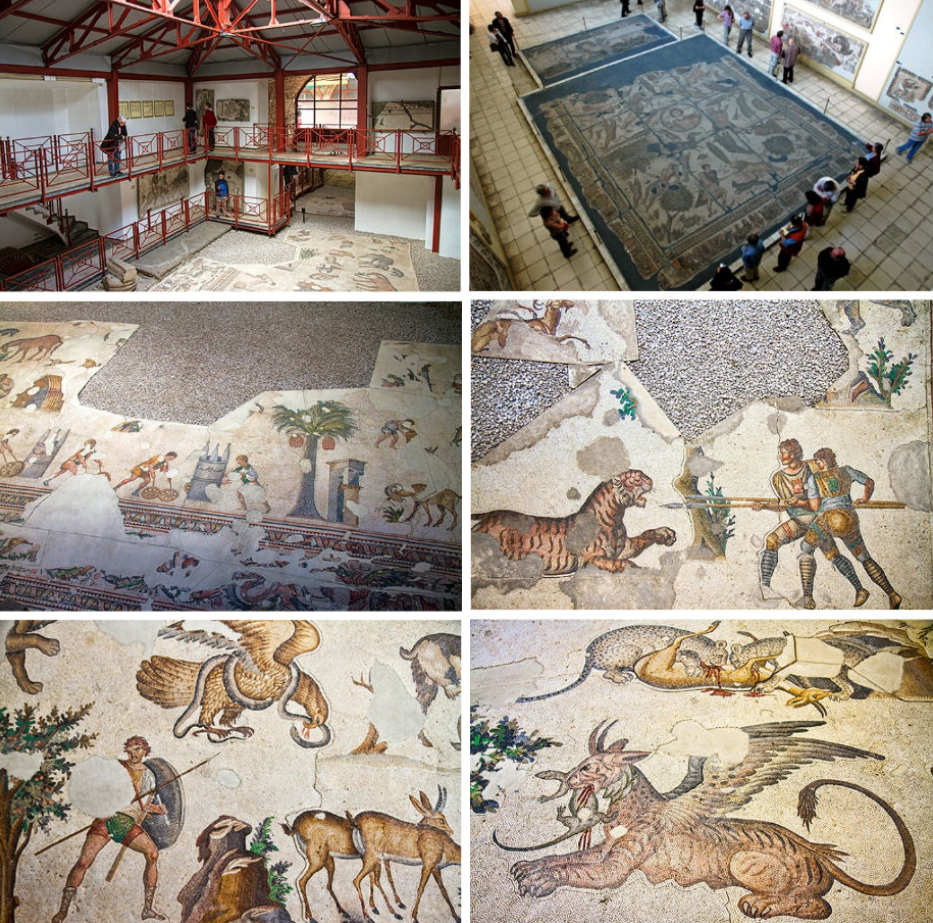
MUSEUM OF TURKISH AND ISLAMIC ARTS : (1 hour approximately )
The museum exhibits a collection of more than 40,000 objects of different categories: carpets, ceramics, sculptures, sarcophagi and even various versions of the Koran. One of the objects that most caught our eye is the door of the great mosque of Cizre.
In addition to this collection, the museum includes an interesting small ethnological section where you can see reconstructions of daily life from different places and times in Turkey.
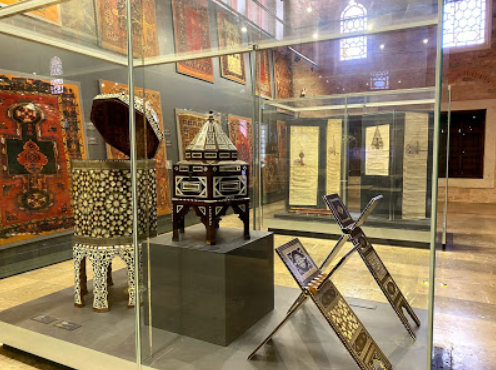
As with the Archaeological Museum, the Museum of Turkish and Islamic Art contains a wide variety of ancient objects. If you like to visit historical museums, you are sure to like this. In addition, the ethnological section is very well maintained.
In the courtyard of the museum you will find a terrace with a fantastic view of the Blue Mosque. A perfect place to have tea.
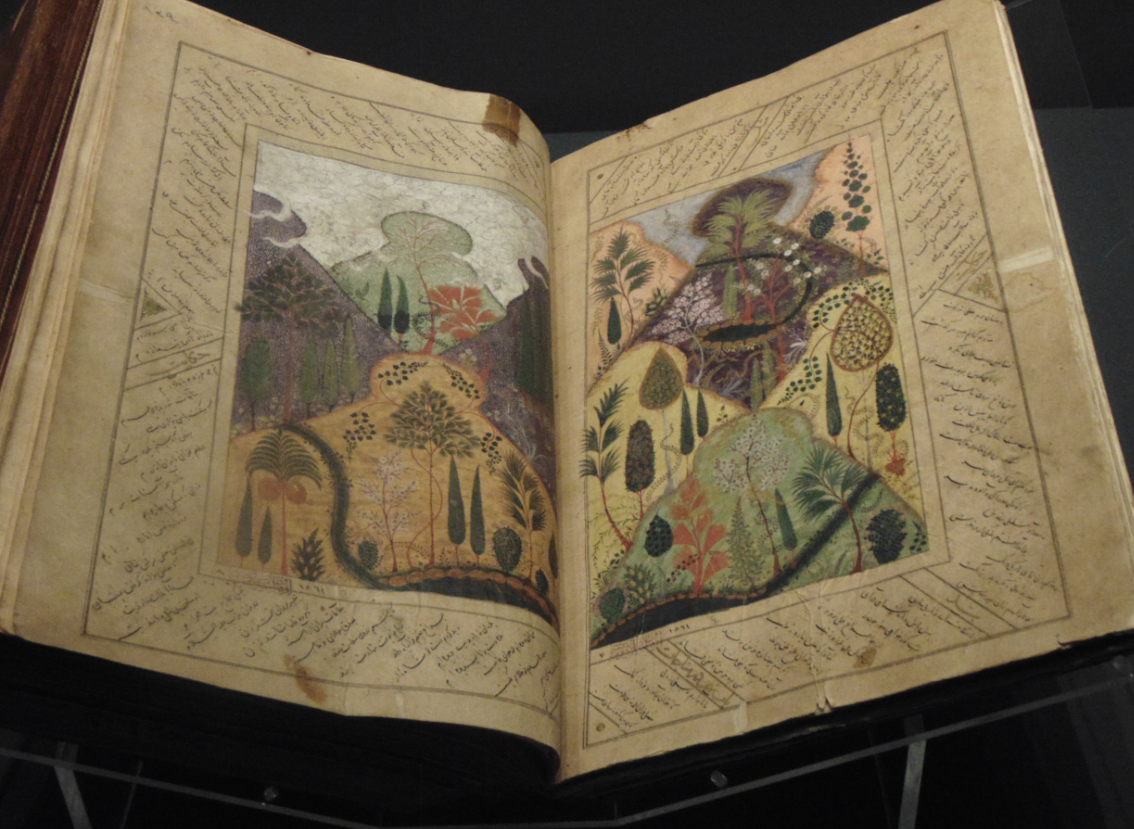
END OF THE DAY . FREE TİME + NIGHT AT THE HOTEL
WEDNESDAY - DAY 4
breakfast at the hotel
A day of shopping and historic places of the sultans not to be missed.
Saint-Sauveur-in-Chora, Market and bazaar of the Fatih district (The largest and most varied in Istanbul only on Wednesdays), Fatih mosque and mausoleum of Fatih Mehmed `` the conqueror '', mosque district Süleymaniye de Soliman, mausoleum of Suleyman `` the magnificent '' and his wife Roxelane, mausoleum of the architect Sinan (Architect of important monuments in Turkey), small coffee-tea break on a terrace overlooking Istanbul, the Grand Bazaar (More big covered bazaar of the world)
SAINT-SAUVEUR-IN-CHORA (1 hour approximately )
Let's start with a work of art: Saint-Sauveur-in-Chora (Turkish: Kariye Müzesi, Kariye Kilisesi or Kariye Camii either "museum of the Chora", "church of the Chora" or "mosque of the Chora") is a of the finest examples of Byzantine churches. The church is currently located in the western stanbouliote district of Edirne Kapı. In 1511, the church was converted into a mosque by the Ottoman Turks. It became a museum in 1948, then was converted into a mosque on August 21, 2020
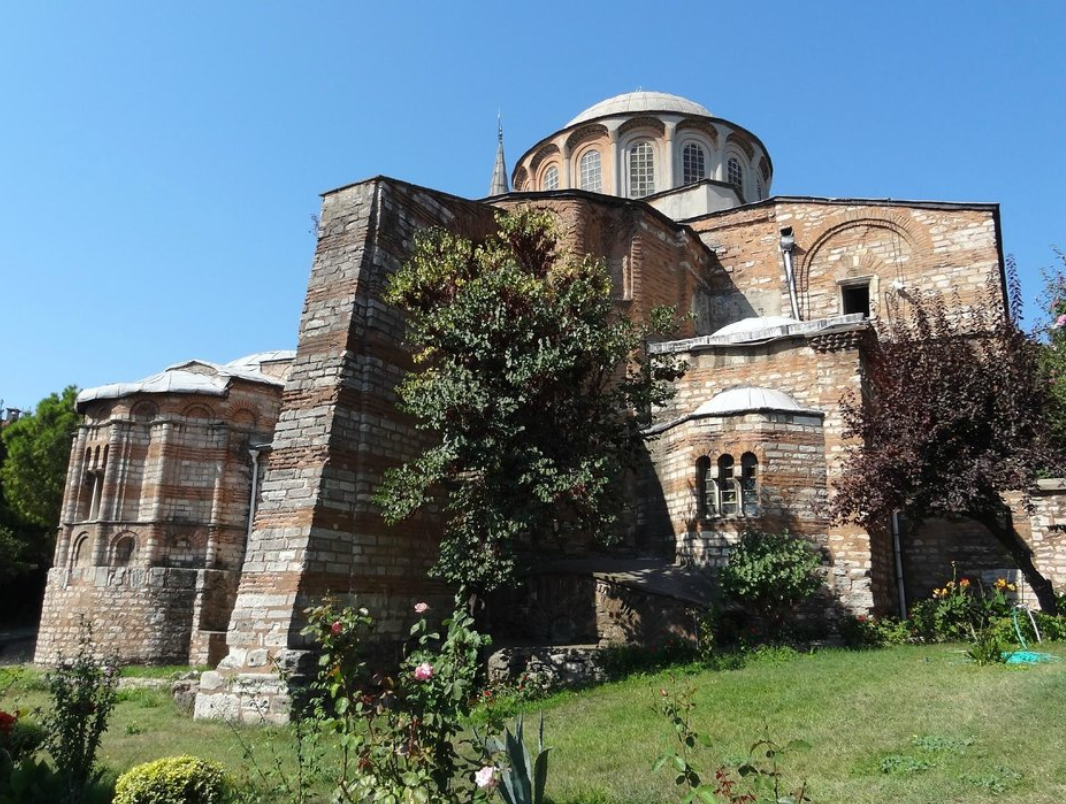
Characteristics of the Church of Saint-Sauveur-in-Chora
The Church of Saint-Sauveur-in-Chora is divided into three parts: the entrance hall (narthex), which is made up of the outer narthex (exonarhex) and the inner narthex (esonarthex), the body of the Church (naos ) and the chapel (parecclesion).
The Church of Saint-Sauveur-in-Chora is mainly renowned for the splendor of the mosaics and frescoes found inside. The mosaics and frescoes largely date from the 13th century and the 14th century, a period assimilated to the pre-Renaissance. These mosaics and frescoes represent different stages in the life of Jesus, Mary, various saints of the Church, and important figures of the Byzantine era.
Outside, the Church of Saint-Sauveur-in-Chora looks quite small compared to other churches built in Istanbul. The building of the Church of Saint-Sauveur-in-Chora has six domes: three in the naos, two in the esonarthex and one in the parecclesion
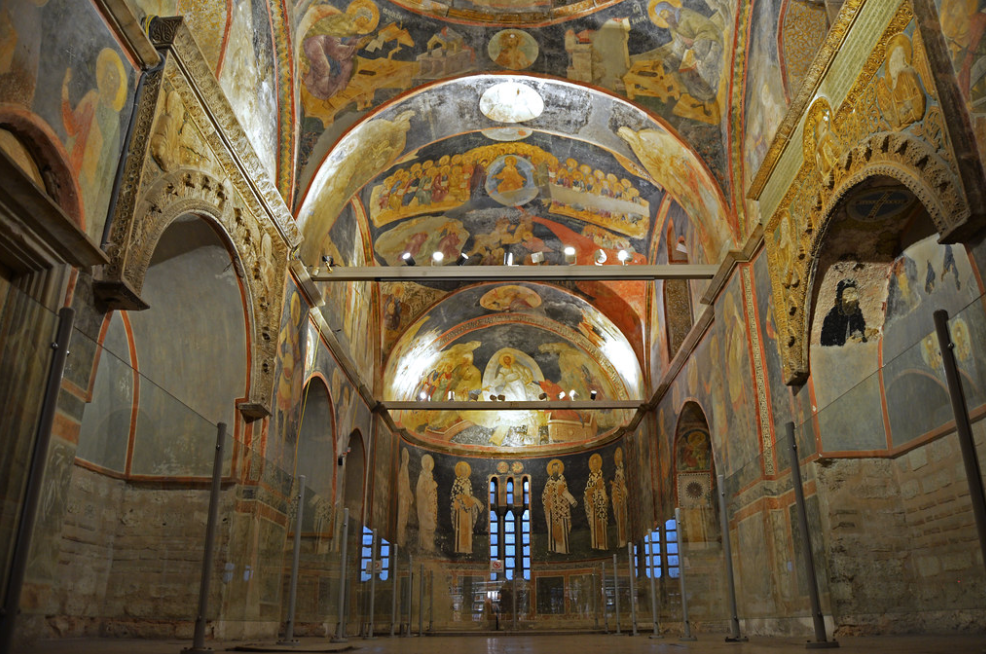
FATIH DISTRICT ( 2 hour approximately)
Market and bazaar of the Fatih district (only Wednesdays)
The Wednesday Market (Çarşamba Pazarı) is one of the oldest and the largest in Istanbul. It’s spread throughout the streets around the Fatih Mosque and in the Çarşamba neighborhood.

A visit to the market is a fantastic experience for anyone visiting the city. Hundreds of stalls are set up and traffic stops for a day to allow locals to shop for everything from fresh fruits and vegetables to clothing to household goods and electronics.
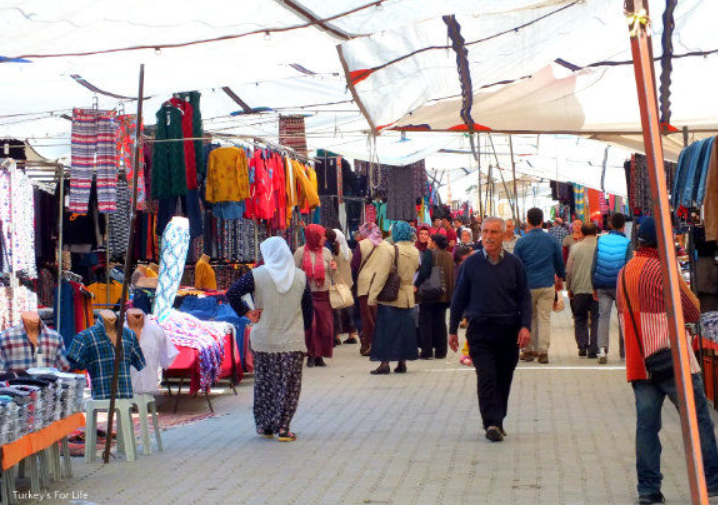
FATIH MOSQUE AND MAUSOLEUM OF FATIH MEHMED `` THE CONQUEROR '
Located in the middle of the historical peninsula of Istanbul in Fatih neighbourhood, the Fatih Mosque (Fatih Camii) is the mosque of Fatih Mosque Complex (Fatih Külliyesi) commissioned in 1463, ten years after the conquest of Constantinople by the Ottomans in 1453. The construction of the mosque lasted seven years and was finished in 1470. It was the Ottoman Sultan Mehmet II (Mehmet the Conqueror) who commissioned the mosque, therefore his name was given to the mosque as well as neighbourhood. In Turkish, Fatih means “the conqueror”.
Fatih Mosque Complex used to contain several other structures including madrasas (religious high schools), dormitory for students, hospice, library, hospital, market, hamam, and tombs; unfortunately only madrasas, library, hospice, and tombs
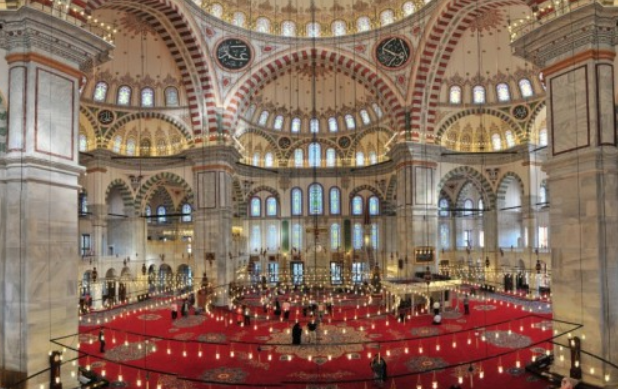
After enjoying the lovely interior, move to Mehmed’s tomb, a popular place of worship, right behind it.
Tomb of Mehmed II
The first tomb belongs to Sultan Mehmed II. The construction date is unknown, but the original tomb was destroyed by a powerful earthquake on May 22, 1766. It was rebuilt along with the mosque by Sultan Mustafa III. The architect was Mehmed Tahir Ağa.
The tomb is lavishly decorated with beautiful designs from the floor to the dome. Calligraphy panels and antique items complement the decor.
Mehmed II (b. 1432, Edirne – d. 1481, Hünkârçayırı, near Gebze) was the 7th Sultan of the Ottoman Empire (r. 1444-1446, 1451-1481). He was also known as Mehmed the Conqueror (Fatih Sultan Mehmet). He conquered Constantinople at the age of 21 and went on to take Serbia, Bosnia, Trebizond, Wallachia, Albania, parts of Greece, and other territories.
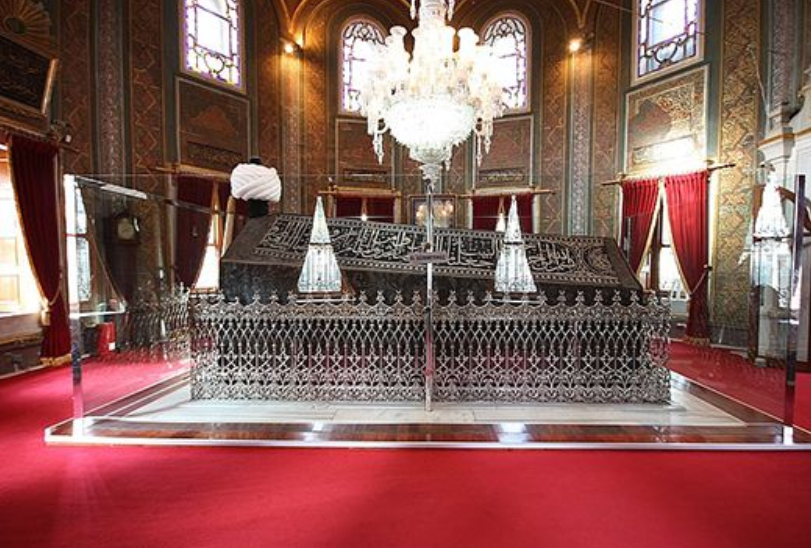
Mehmed II spoke Turkish, French, Latin, Greek, Serbian, Persian, Arabic and Hebrew fluently, and was one of the most powerful and open-minded leaders of his time. He enacted several political and social reforms and encouraged the arts and sciences. As long as they were obedient to his rule, his subjects were allowed a great deal of religious freedom. Mehmed II also built Topkapi Palace.
DISTRICT SÜLEYMANIYE (2 hour approximately)
Mosque district Süleymaniye de Soliman, mausoleum of Suleyman `` the magnificent '' and his wife Roxelane
The Süleymaniye crowns one of İstanbul's seven hills and dominates the Golden Horn, providing a landmark for the entire city. Though it's not the largest of the Ottoman mosques, it is certainly one of the grandest and most beautiful. It's also unusual in that many of its original külliye (mosque complex) buildings have been retained and sympathetically adapted for reuse.
Commissioned by Süleyman I, known as 'the Magnificent', the Süleymaniye was the fourth imperial mosque built in İstanbul; the mosque's four minarets with their 10 beautiful şerefes (balconies) are said to represent the fact that Süleyman was the fourth of the Osmanlı sultans to rule the city and the 10th sultan after the establishment of the empire. The mosque and its surrounding buildings were designed by Mimar Sinan, the most famous and talented of all imperial architects. Construction occurred between 1550 and 1557.
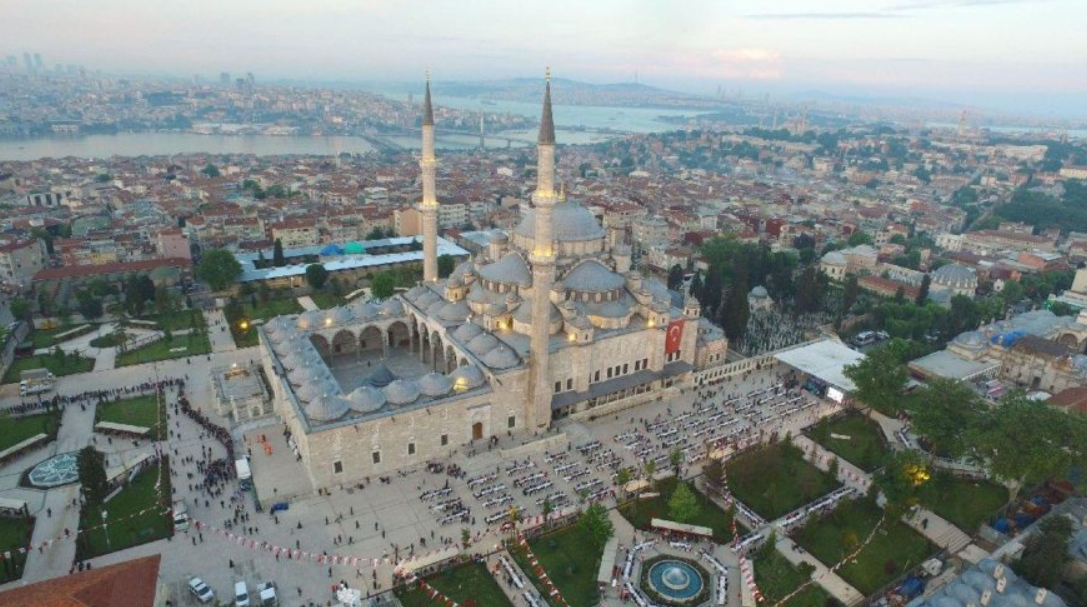
Also in the Sülemaniye Külliyesi (mosque complex), there is a medrese (religious school), soup kitchen, hospital, caravanserai, library, bazaar and several tombs. Some of these facilities are still in use today.
Notable are the tombs of Süleyman the Magnificent and his wife, Haseki Hürrem, (also known as Roxelana). Both are impressive; inlaid with precious metals, stones and stained glass. The tomb of the architect, Mimar Sinan, is also located here, in the north-western corner.
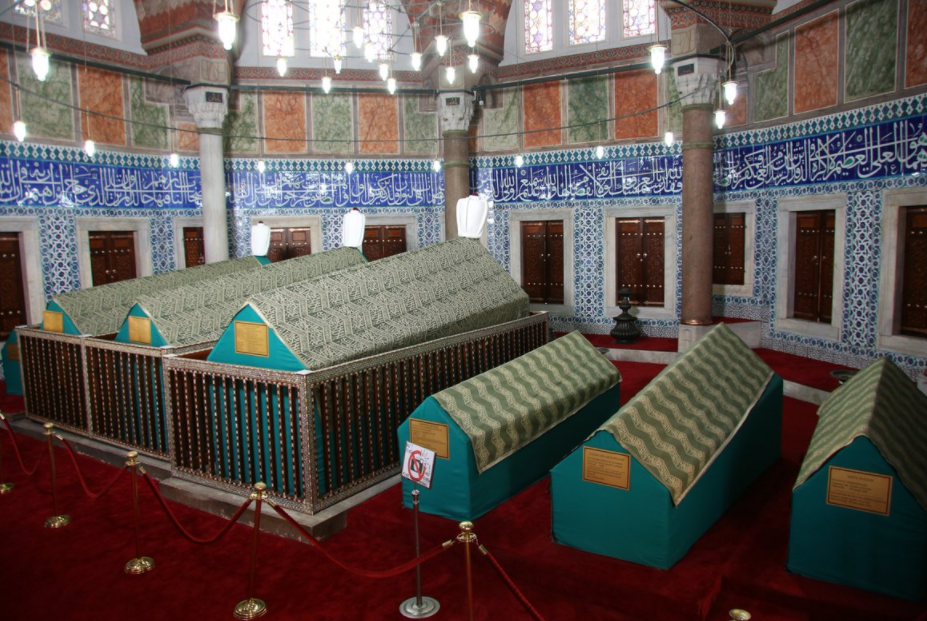
A small enclosure behind the Süleymaniye Mosque , contains two tombs and a cemetery. The entrance is through a gate on the north side of the mosque, and the tombs are included in the UNESCO World Heritage listing of the Historic Areas of Istanbul.
Tomb of Süleyman I
The first structure is the tomb of Süleyman I (Kanuni Sultan Süleyman Türbesi), which was built in 1566. It contains a peristyle with a roof supported by 24 columns. The entrance is decorated with Iznik tiles
Mausoleum of the architect Sinan (Architect of important monuments in Turkey)
The Mausoleum of Sinan the Architect, located on the corner across the Eski Ağalar Gate of the Süleymaniye Mosque, on a triangular land at the road intersection. Sinan the Architect had personally built this mausoleum with six columns, that is covered at the top and the perimeter of which is open, and has a fountain made of pure marble in front.
Among the masterpieces of Sinan the Architect, who has lived during 1490 - 1588 and is the most important name of Turkish architectural history by his works expanding over a broad geography as the chief architect of Suleiman the Magnificent, the Süleymaniye and Selimiye Mosques are listed among the most distinguished specimens of world architecture.
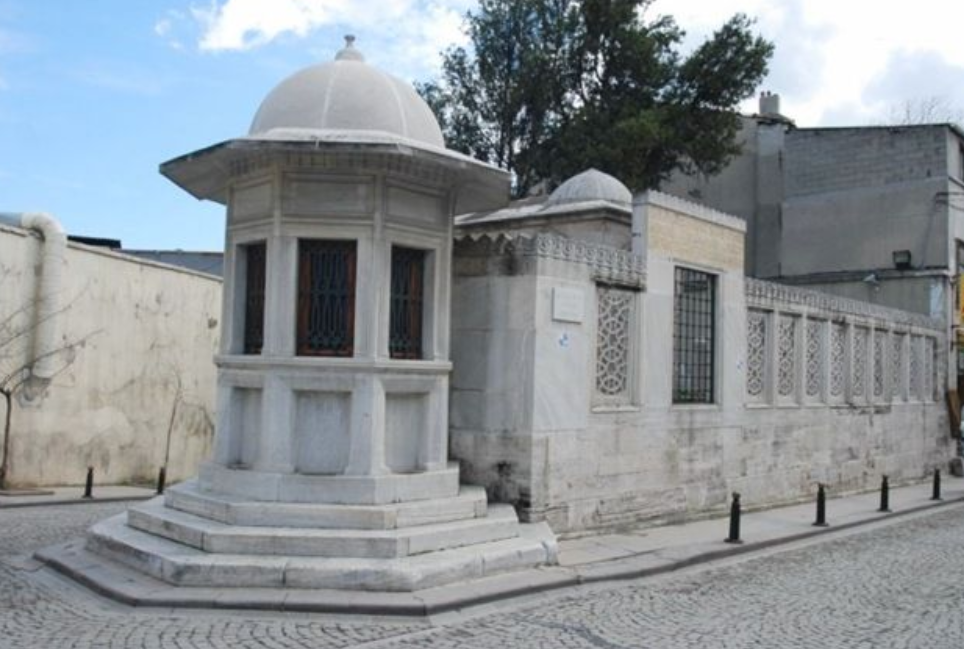
The engineering solutions that Sinan the Architect, who has designed and built 364 buildings throughout his life, as 84 mosques, 53 masjids, 57 madrasahs, 7 darülkurra (Koran reading schools), 22 mausoleums, 17 soup-kitchens, 3 darüşşifa (hospitals), 5 aqueducts, 8 bridges, 20 caravansaries, 35 palaces, 8 vaults and 48 baths, developed by setting off from the verse “We buried mountains on earth like nails...", are renowned by their feature of adding static strength as well as aesthetics and splendor to buildings.
Small coffee-tea break on a terrace overlooking Istanbul
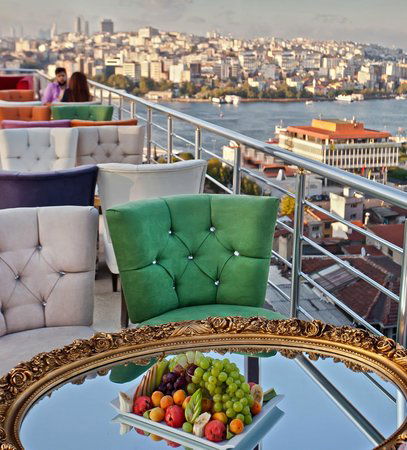
THE GRAND BAZAAR - (1 hour approximately )
The Grand Bazaar, Kapali Carsi ("the covered market") in Turkish, is located in the Beyazit district (Istanbul). With 60 aisles and more than 4,000 shops spread over 30 hectares, today it is one of the largest bazaars in the world.
You can enter the Grand Bazaar through 18 different gates on all sides of the building. Through the many alleys composing it, the bazaar is divided into districts, each grouping a lot of products.
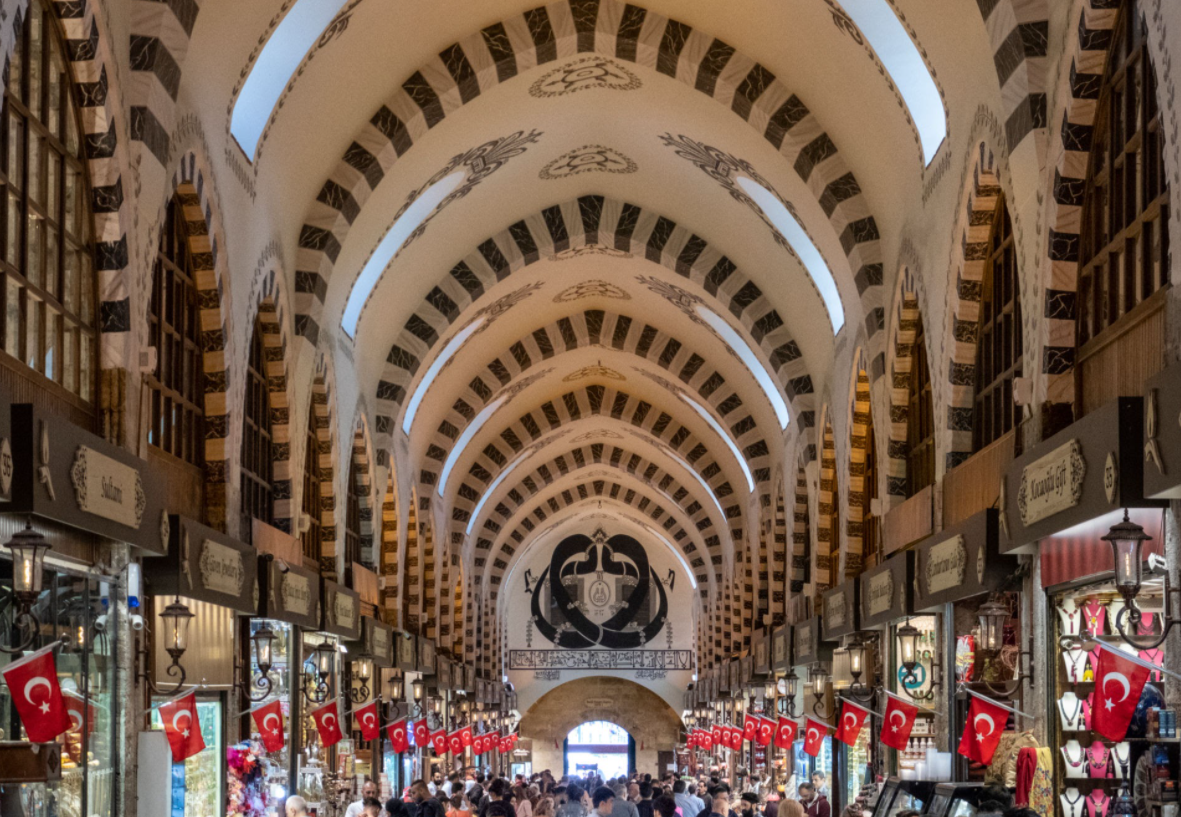
There are five major districts in the Grand Bazaar:
The leather district
The textile district
The souvenir district
The district of jewelers and jewelers
The antiques and carpet district
From the Grand Bazaar, you can also walk to the Egyptian Bazaar where you will find a large selection of Turkish spices and pastries.
The Grand Bazaar is a place not to be missed in Istanbul.
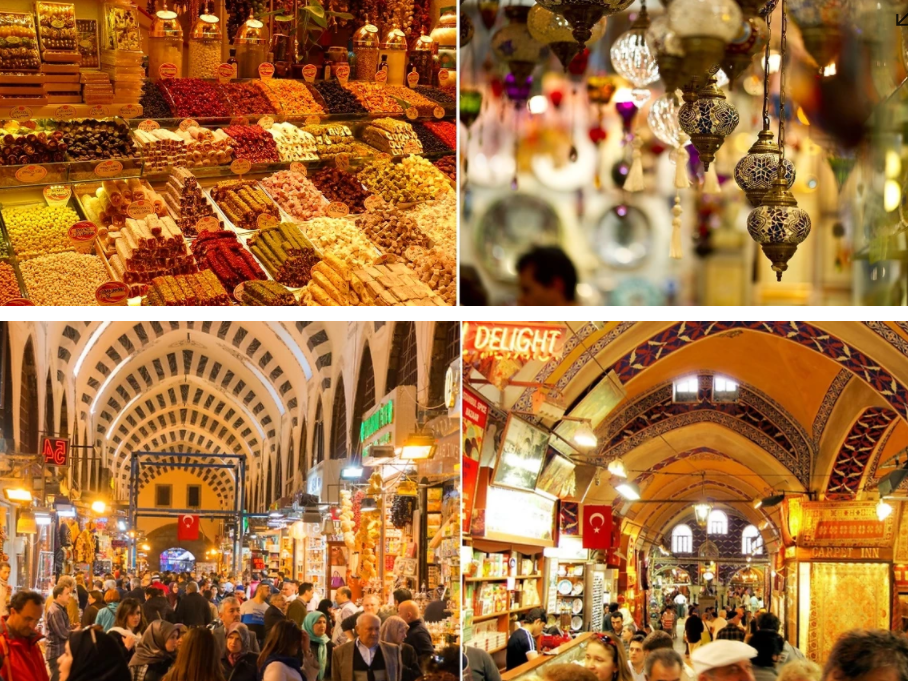
END OF THE DAY . FREE TİME + NIGHT AT THE HOTEL
THURSDAY - DAY 5
breakfast at the hotel
Dolmabahçe Palace (Haremlik and Selamlık) last home of the last sultans and caliph of Islam and Atatürk Mustafa Kemal, Ortaköy Mosque (Famous place of Turkish series and for its Kumpir restaurant based on potatoes),Underground Mosque, Taksim square and the famous istiklal street walk past the Galata Tower.
DOLMABAHÇE PALACE (HAREMLIK AND SELAMLIK) - ( 3 hour approximately )
Last home of the last sultans and caliph of Islam and Atatürk Mustafa Kemal
Dolmabahce Palace built in 19 th century is one of the most glamorous palaces in the world. It was the administrative center of the late Ottoman Empire with the last of Ottoman Sultans was residing there.
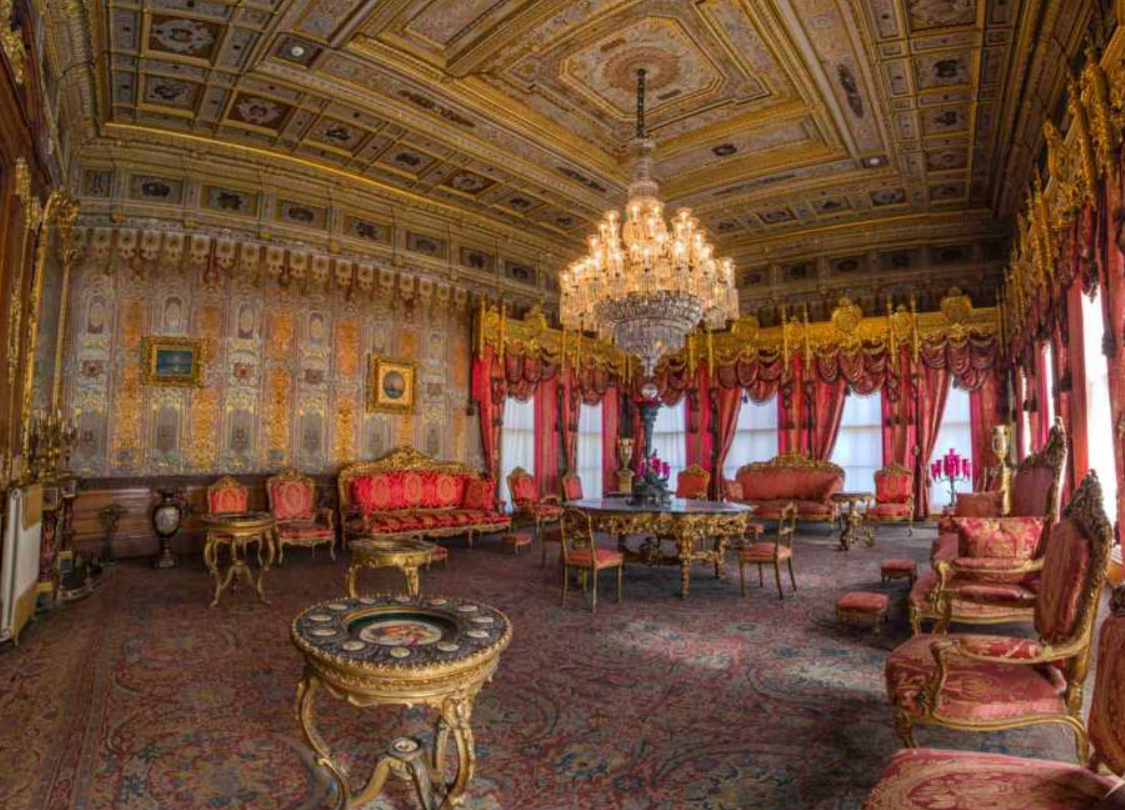
Starting with the move of the administrative center of the Ottoman Empire from Topkapi Palace in 1856, until the abolishment of the caliphate in 1924, the Dolmabahçe Palace was home to six sultans. There was however a 20-year interval from 1889 to 1909 in which the Yıldız Palace was used.
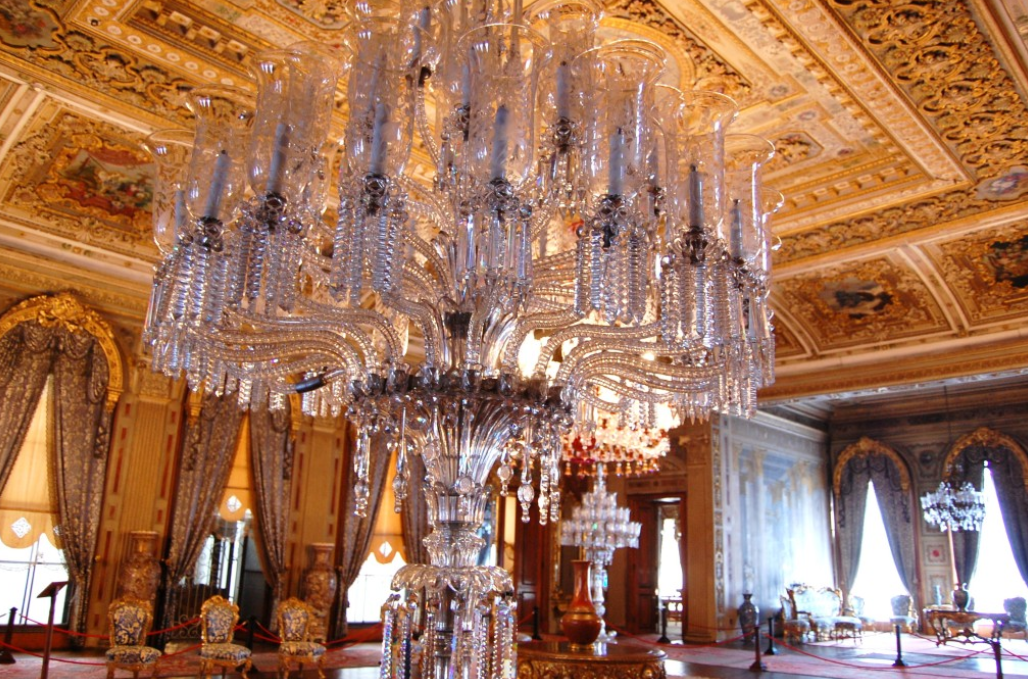
ATATÜRK'S ROOM
Six Sultans and Atatürk
Mustafa Kemal Atatürk, the founder of the Turkish Republic, used the palace as a presidential house in the summer and enacted some of his most important works here, e.g. the introduction of the new alphabet. Troubled by health problems, he spent his last years in the palace until he died at 09.05 on November 10, 1938. In his honor, all the clocks in the palace are stopped at that exact time. The room in which he died is part of one of the palace tours.
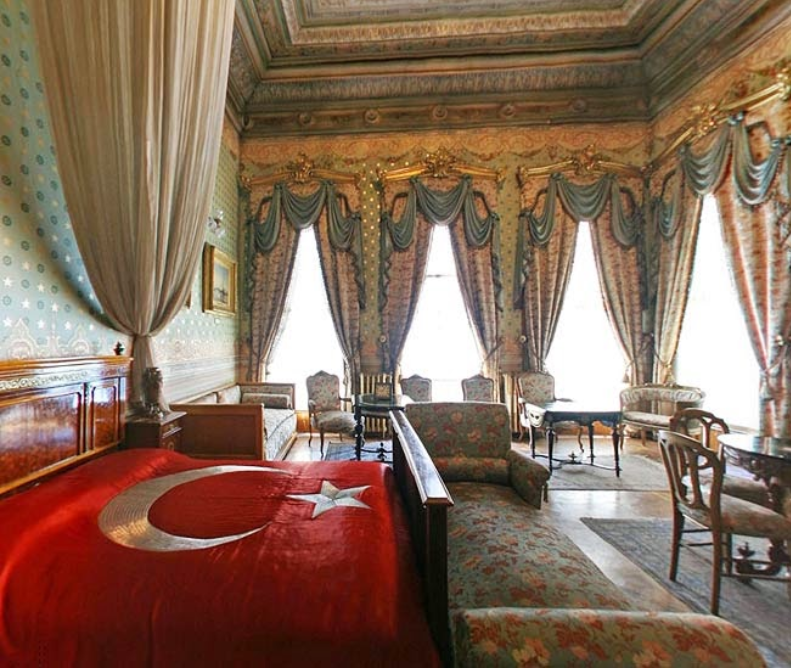
ORTAKÖY MOSQUE - ( 2 hour approximately )
Ortaköy Mosque has one of the most picturesque settings of all of the Istanbul mosques.
Located just before the Bosphorus Bridge, the Ortaköy Camii, has to have one of the most picturesque settings of all of the Istanbul mosques. Indeed, Ortaköy Mosque photos, with the bridge the background are often used to demonstrate that particular Istanbul juxtaposition of traditional and modern.
Ortakoy (Ortaköy) Mosque History
Built on the sight of an 18th century mosque (built by Mahmut Ağa, the son-in law of Grand Vizier Ibrahim Pasha), the current building was completed in 1855, to serve as the Büyük Mecidiye Camii (Grand Imperial Mosque) to the Ottoman Sultan Abdülmecid. It was designed by Armenian architect, Garabet Balyan, and his son Nigoğayos Balyanl, who were also responsible for the nearby Dolmabahce Palace.
It is neo-Baroque in style, with an ornate exterior, and large windows that allow light to flood into its plainer interior. The main chamber is small and square shaped, its edge 12.25m in length. The ceiling is a dome shape, covered in pink mosaics. There are two tall minarets, each with a single sherefe (minaret balcony). Attached is the two storey Hünkar Kasrı (sultan’s summer palace).
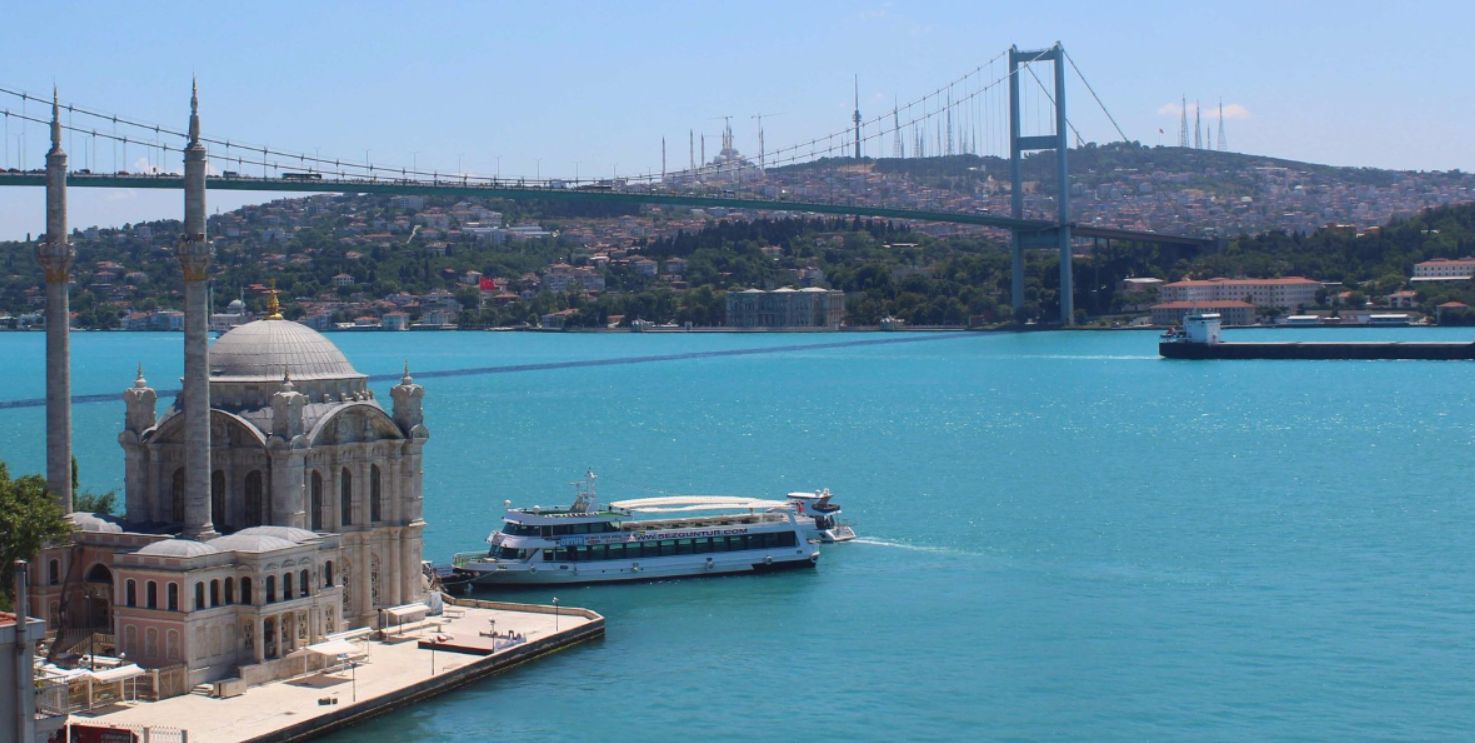
UNDERGROUND MOSQUE - ( 30 minutes approximately )
A surprising and unconventional mosque hidden in the subsoil of Istanbul.
Hidden among the alleyways of the karaköy harbor there is an amazing Ottoman mosque that, in stark contrast to the great height of most Islamic temples in Istanbul, is situated sunken into the earth. For this reason it was dubbed the “Underground Mosque,” or “Yeralti Camii” in Turkish.
The ceiling is very low and the space is dark, illuminated with just a few lamps and some strident green fluorescents that illuminate the ancient tombs of two martyrs.
The maqam tombs of Amr bin al-As of the companions, Vehb B. Huşeyre (there is no information as to whether he is a companion) and Süfyân B. Uyeyne of Tebeu't-tabiîn are also here. It is considered the most visited holy place in Istanbul after Eyüpsultan.
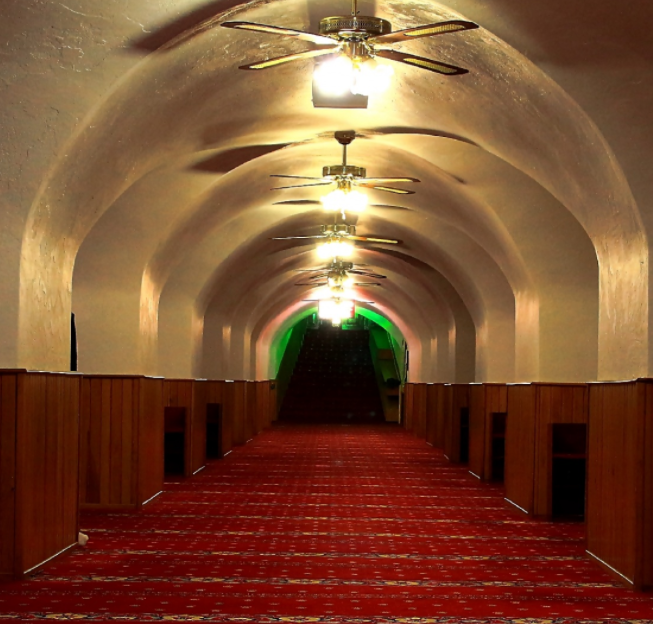
TAKSIM SQUARE AND THE FAMOUS ISTIKLAL STREET WALK PAST THE GALATA TOWER - ( 2 hour approximately )
You'll head to the area of Galata, at the end of Istiklal street. It is one of the most historic areas in Istanbul. Its best-known attraction is Galata Tower which was built in 1348 by the Genoese colony who lived there and called the "Tower of Christ". From that time to 1453, when Constantinople was conquered by the Ottomans, Galata was mostly inhabited by Genoese and Venetian Catholics, as well as some Greek, Armenian and Jewish families.
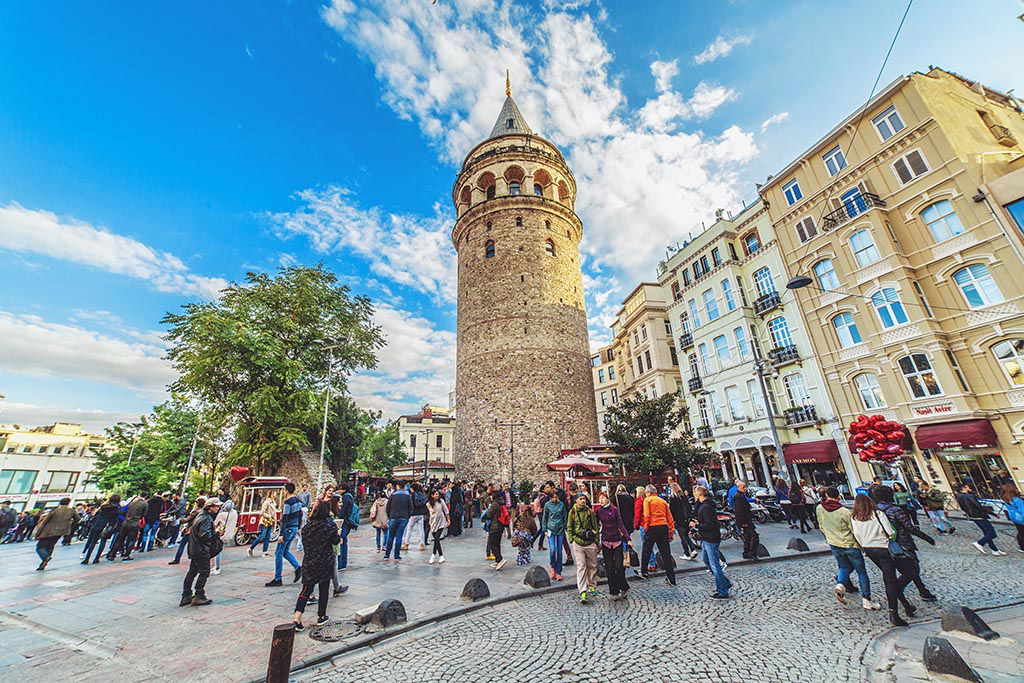
Istiklal Street, which is one of the most popular streets in the city for locals and tourists. It is full of small boutique shops, big international stores, embassies, luxury hotels, apartment buildings, churches, museums and more, so it will be an interesting walk with lots to see! There are also many restaurants, cafes, bars and clubs. At night, Istiklal Street is one of the busiest spots in the city.

The Taksim Square is a cosmopolitan one, also a communications hub and an important commercial, entertainment and sightseeing area for both locals and tourists in Istanbul. Taksim Square is also a popular meeting point and ideal place to have a nice Istanbul city walking tour from Taksim.
Many popular tourist places like restaurants, pubs, bars and cafes, sights, museums are situated along the square.End of the day's visit to the square
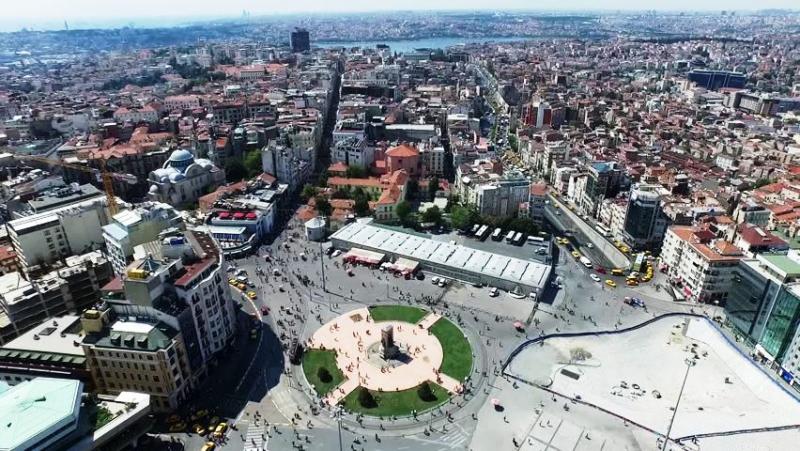
END OF THE DAY . FREE TİME + NIGHT AT THE HOTEL
FRIDAY - DAY 6
breakfast at the hotel
Visit of the Mosque of Eyüp, if possible visit of the Mausoleum of the Eyüp el Ansari (One of the companions of the prophet Muhammed), Free time for Friday prayer, and go Pierre Loti hill.
EYUP SULTAN MOSQUE & AYYUB AL-ANSARI TOMB
The Mosque of Eyüp, Eyüp Sultan Camii in Turkish, is located in the district of Eyüp (Istanbul). The Eyüp Mosque was built in 1458, five years after the capture of Istanbul by the Ottomans, during the reign of Sultan Mehmet II.
The Eyüp Mosque was erected in honor of Abu Ayyub al-Ansari, one of the companions of the Prophet Muhammad, who died in Istanbul in 670, and who is commonly referred to as Eyüp Sultan by the Turks. The Eyüp Mosque is therefore one of the most important holy places in Islam.
The Eyüp Mosque is part of a complex built around the tomb of Eyüp Sultan. In addition to the Eyüp Mosque, this complex then included a madrasa and a hammam.
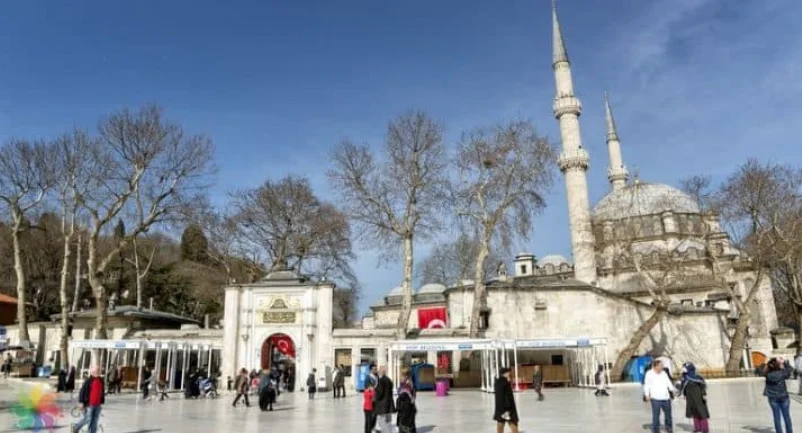
Ayoub Ansari, standard-bearer of the Prophet Muhammed, is said to have fallen in battle during the attack on the walls of Constantinople by Arab armies in the 700s. He was buried on the shores of the Golden Horn.
In 1453, during Sultan Mehmet II’s siege of Constantinople, the grave of the standard-bearer was said to have been miraculously rediscovered, a miracle which inspired the sultan’s Ottoman troops to endure the siege and proceed to victory over the Byzantines.
Hence the grave of Ayoub (Eyüp in Turkish) is a sacred site in both religion and Turkish political history, as Eyüp was not only a friend of the Prophet but the key to the greatest Ottoman victory.
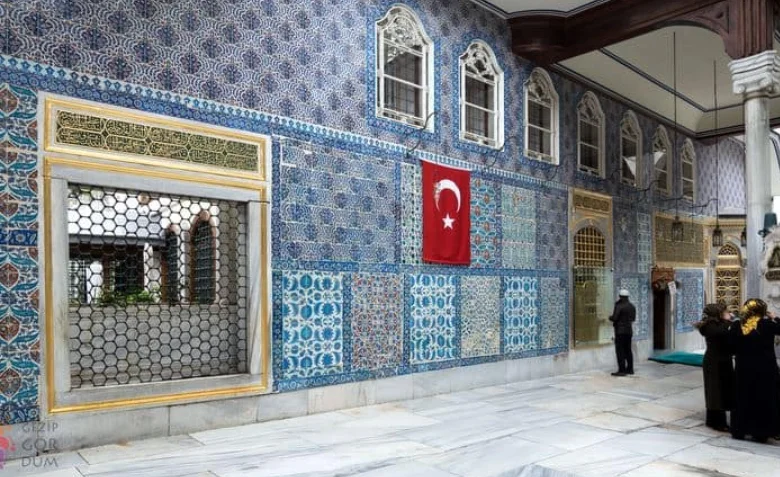
Free time for Friday prayer
PIERRE LOTI
We will then take the cable car to Pierre Loti Hill to enjoy a tea or coffee at the cafe and take in the stunning view of the Golden Horn.
The Historical Pierre Loti Coffeehouse Centuries-old coffeehouse is famous for its magnificent view of the Golden Horn. Until the end of the 19th century it was known as the labia Kadin Coffeehouse, but after the French writer Pierre Loti began to visit the coffeehouse frequently, it became known by his name. For years the coffeehouse has been a meeting place for lovers, a place where they can draw a spiritual breathe of peace away from the city.
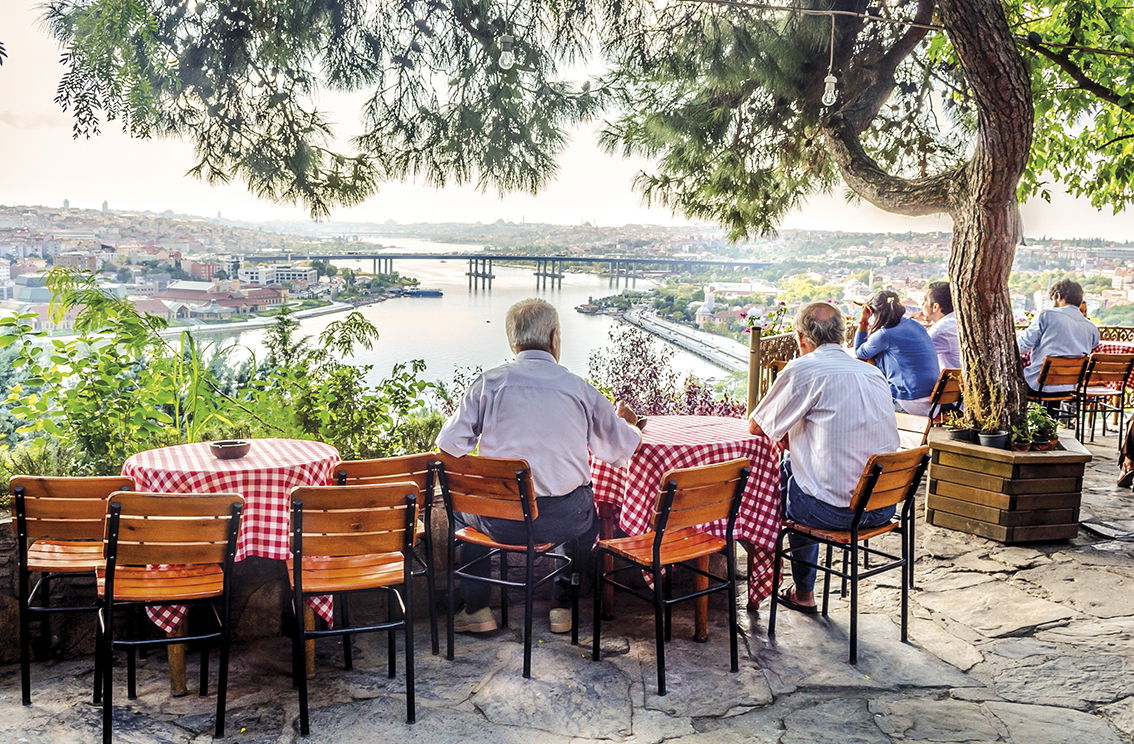
Loti (1850-1923) was a famous French writer and orientalist. A naval officer, Pierre Loti came to Turkey for the first time in 1876 and stayed one year. He discovered the historical coffeehouse that year. It was not only the beauty of the Golden Horn that drew him there; it was also a married Ottoman woman called Aziyade. The great love between Loti, who was married in France, and Aziyade has been talked about for years until it has become legendary. In his novel, Aziyade, Pierre Loti makes no secret of his romance.
END OF THE DAY . FREE TİME + NIGHT AT THE HOTEL
SATURDAY - DAY 7
breakfast at the hotel
Last day of Istanbul where we visited magical monuments between East and West .
DEPARTURE FOR THE AIRPORT AND BACK TO ANTALYA
ADDITIONAL ACTIVITIES
We can if you wish organize themed excursions for your free evenings. Here are our different possibilities:
*** BOAT TRIP ON THE BOSPHORUS ****
We have 3 cruise packages on the Bosphorus:
1) From the European side to the Asian side by Vapur boat and return by Tramway under the sea of the Bosphorus. Duration about 1 hour 30 minutes. (approximately)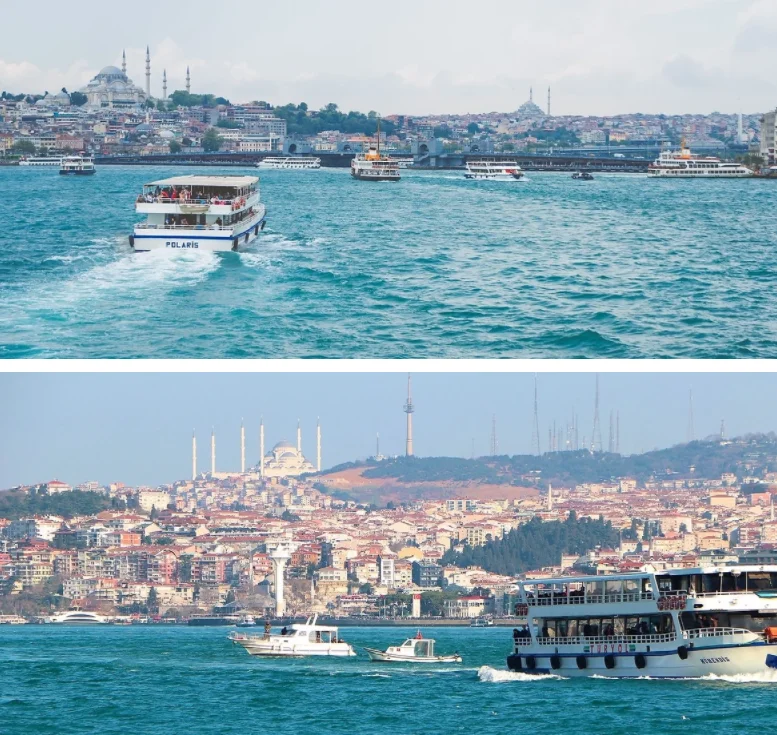 2) Bosphorus Cruise and Turkish Show (All Inclusive) Duration: 3 hours 30 minutes (approximately)
2) Bosphorus Cruise and Turkish Show (All Inclusive) Duration: 3 hours 30 minutes (approximately)
Set sail along the Bosphorus, the meeting point of Europe and Asia, on this evening cruise.
See Istanbul at its most atmospheric as you pass the city's illuminated rooftops and see landmarks such as Dolmabahçe Palace, Bosphorus Bridge, and Maiden's Tower. Magnificent view of the illuminated monuments of Istanbul from the water.

On board, participate in a 3-course dinner and enjoy a variety of entertainment, including whirling dervishes, belly dancing, and DJs.
Delicious 3-course dinner with non-alcoholic drinks (extra for alcoholic drinks)
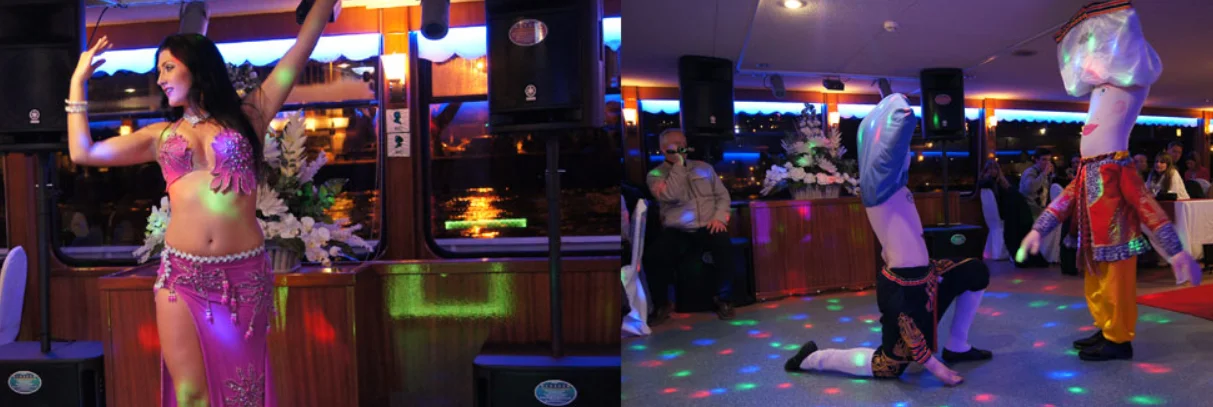
3) Luxury Yacht Cruise on the Bosphorus at Sunset : 2 hours 30 minutes (approximately)
Discover the beauty of the city on this relaxing sunset cruise on the Bosphorus, the waterway that marks the border between Asian Turkey and European Turkey. From the open-air deck of your luxury yacht, see landmarks such as Dolmabahçe Palace, Ortaköy Mosque, and Rumeli Fortress, all illuminated by the magnificent twilight light.
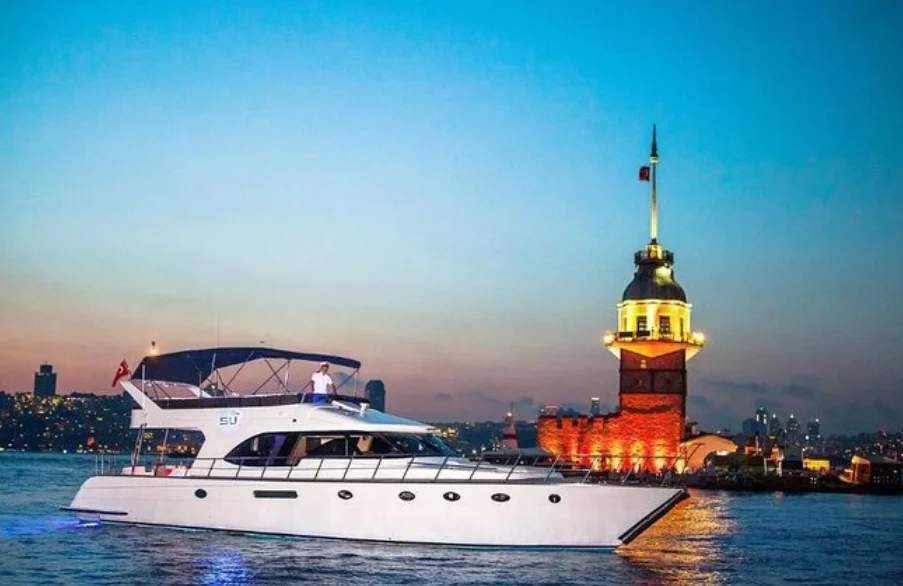
Free drinks and canapes are made available as you cruise
A cruise for all seasons: set sail any time of the year, weather permitting
Drinks offered (and the Tamarind sorbet - Demirhindi şerbeti -, the original Ottoman recipe, made using 41 different spices and herbs), tea and coffee
Delicious canapes and light snacks served on board Coffee and / or tea Snacks
*** '' HAMAM TO RELAX '' ***
After beautiful of sightseeing, a little rest in a hammam to relax
TWO POSSIBILITIES: HAMAM MİXTES OR SEPARATE
Enjoy a session in a Turkish bath (hammam) and discover a traditional method of purification and relaxation.
Relax in the sauna and steam baths and regenerate your skin with a scrub and foam massage.
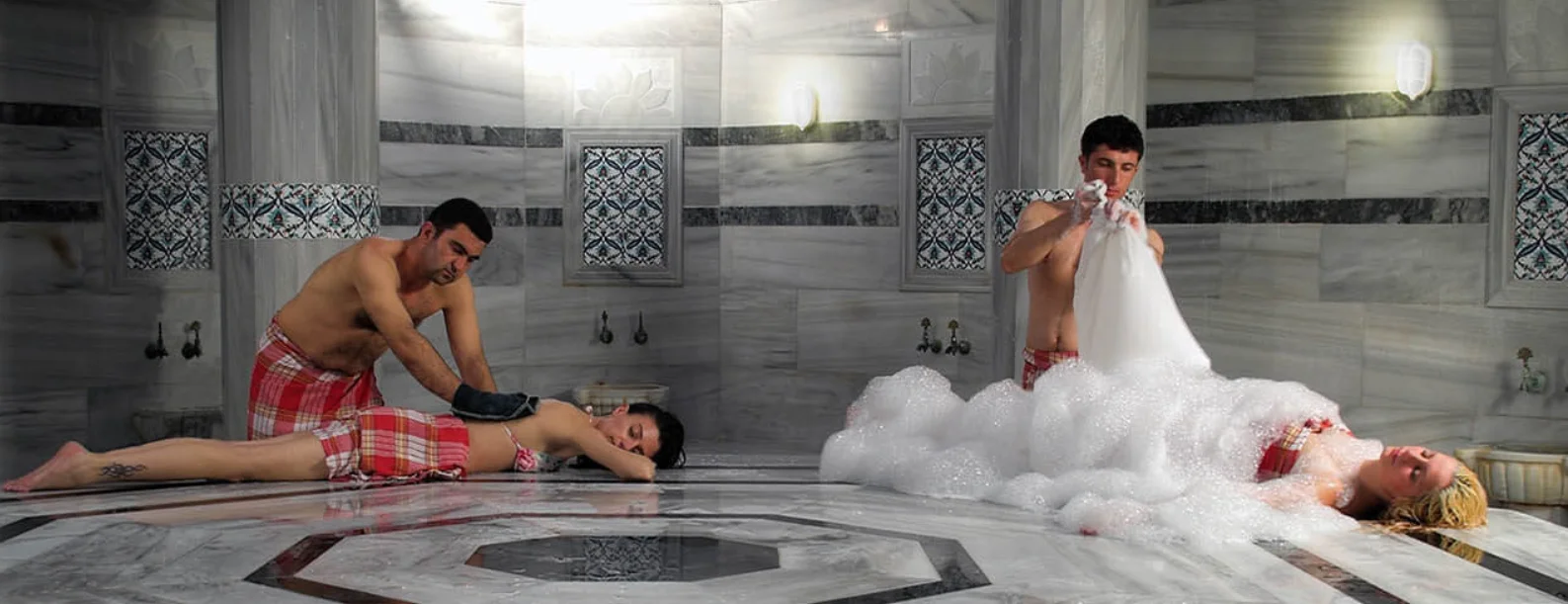
Experience the benefits of a full body oil massage, foam massage and skin scrub. Enjoy one of the most unique Turkish traditions.
sauna
vapor bath
foam massage
oil massage
Important information
Passport or ID required.
This tour is a long day(s) that involves a lot of walking, so it may not be suitable for people with limited mobility or children.
PRICE INCLUDES:
*Hotel pick up-drop off
*Hotel with half board (Only breakfast at the hotel is included )
*Guidance
*Entrance fees
OPTIONAL EXTRAS:
All meals and drinks are not included.Only breakfast at the hotel is included
Important information
Please note that all times are approximate and subject to change.
The Guide may make corrections and adaptations in the course of the tour program according to the conditions and situations of the planned places of visits
Are you looking for a different Turkey tour?
Please check our other Turkey Tours for inspiration or send us an E-MAIL with details of your dream Turkey trip such as your ages, hotel preferences, personal interests and travel type.
We will get back to you with a suitable itinerary.
Imagine dealing with only one person for all your travel details, receiving private itineraries, and recommendations that will fit your travel interests.
Contact us to get a personalized day by day itinerary for your trip to Turkey.
Benefit from our expertise.
We offer tailor-made tours to Turkey for all interests and desires, from romantic honeymoons and scenic self-drive road trips to photo tours with experienced photographers and cultural tours in major destinations.
We arrange everything for your turkey tours , including hotel bookings, airport transfers, guided tours, and top-notch experiences.
We want you to have a great time in Turkey and make sure your trip is a memorable one as we have escorted so many tours in Turkey personally.
For more information or reservation please contact us by mail or WhatsAap


